#The Norse Queen of Scots.
Text
Marlena Caya Hvitserksdóttir
The wild, unpredictable Norse Queen of Scots.
"I may live in Scotland but I have the heart of a Norse."



"You're beautiful and clever and unpredictable. Like your mother, you know how to use your beauty and could have the whole world at your feet. You are aware of it, but you don't use it because other people are more important to you than you are. You are like your mother, a whirlwind but with a heart of gold. There's this fire inside of you that's the same as your mother's. You're a warrior, you know how to fight, but you prefer to use your wits to win wars. That's what makes you who you are, what makes you special." Hvitserk to his daughter.





Marlena Caya Hvitserksdóttir - daughter of Hvitserk and Caya, sister of Illian, granddaughter of the two great men Ragnar and Flóki the boatbuilder, niece of the King and Queen of Kattegat, Ivar the boneless and Xenia Princess of Rus and the cousin of Vidar, Edda and Cailan. Passionate and balanced is what best describes Marlena, but she is also an idiosyncratic woman. She proves to be a formidable enemy for anyone who stands in her way. She is also a great ally as she always puts other people before herself. As a child, Marlena was described as very talkative and free with words, but in her youth she became stronger to stand up for what she believes in. She has grown into an independent woman who will do anything to protect the people she loves and her country. She is a warrior but she is also the romantic, both in equal parts. Many describe her as a truly remarkable woman, very witty, charming, adventurous, wild and full of passion. Taking after her mother, she has an unbridled fire, an unbreakable will and is often unpredictable, but like her mother, she is also an extremely intelligent young woman. She speaks different languages, she rides horses and she is good at hunting. Marlena has a close relationship with her brother, her cousin and her cousins because she grew up with them. Family always comes first for her, which she would not hesitate to defend and protect with her own life at any time. Her father is her great hero, whom she loves more than anything else. Marlena also has a very close relationship with her grandfather, her uncle and her aunt and loves them unconditionally. She is a real whirlwind with the heart of a Norse, strong belief in the gods and the destiny given by them. Because of a planned alliance between Norway and Scotland, she was sent to Scotland together with her brother, her cousin, her cousins and her confidant Marcellus to meet and marry the Scottish king. On the day of her marriage, she was crowned Queen of Scots. Shortly after their marriage, the king died, making her the sole ruler of Scotland. Even though she is a kind queen who loves her people and always does everything she can to protect the people of Scotland, Marlena or her power and influence should not be underestimated.
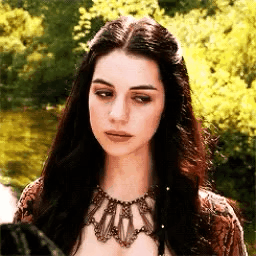
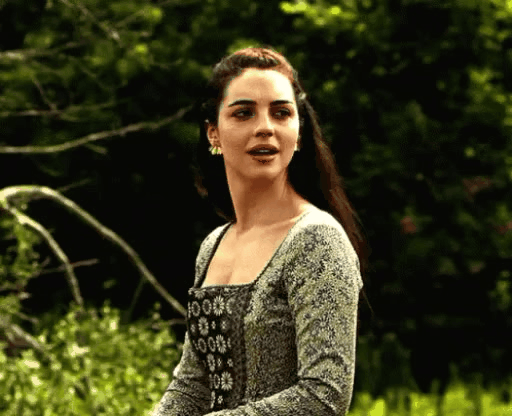
14 notes
·
View notes
Text
Online History Short-Courses offered by Universities Masterpost
Categories: Classical Studies, Egyptology, Medieval, Renaissance, The Americas, Asia, Other, Linguistics, Archaeology
How to get Coursera courses for free: There are several types of courses on Coursera, some will allow you to study the full course and only charge for the optional-certificate, for others you will need to audit it and you may have limited access (usually just to assignments), and thirdly some courses charge a monthly subscription in this case a 7 day free trial is available.
Classical Studies 🏛️🏺
At the Origins of the Mediterranean Civilization: Archeology of the City from the Levant to the West 3rd-1st millennium BC - Sapienza University of Rome
Greek and Roman Mythology - University of Pennsylvania
Health and Wellbeing in the Ancient World - Open University
Roman Architecture - Yale
Roman Art and Archeology - University of Arizona
Rome: A Virtual Tour of the Ancient City - University of Reading
The Ancient Greeks - Wesleyan University
The Changing Landscape of Ancient Rome. Archeology and History of Palatine Hill - Sapienza University of Rome
Uncovering Roman Britain in Old Museum Collections - University of Reading
Egyptology 𓂀⚱️
Egypt before and after pharaohs - Sapienza University of Rome
Introduction to Ancient Egypt and Its Civilization - University of Pennsylvania
Wonders of Ancient Egypt - University of Pennsylvania
Medieval 🗡️🏰
Age of Cathedrals - Yale
Coexistence in Medieval Spain: Jews, Christians, and Muslims - University of Colorado
Deciphering Secrets: The Illuminated Manuscripts of Medieval Europe - University of Colorado
Enlightening the Dark Ages: Early Medieval Archaeology in Italy - University of Padova
Lancaster Castle and Northern English History: The View from the Stronghold - Lancaster University
Magic in the Middle Ages - University of Barcelona
Old Norse Mythology in the Sources - University of Colorado Bolder
Preserving Norwegian Stave Churches - Norwegian University of Science and Technology
The Book of Kells: Exploring an Irish Medieval Masterpiece - Trinity College Dublin
The Cosmopolitan Medival Arabic World - University of Leiden
Renaissance ⚜️🃏
Black Tudors: The Untold Story
European Empires: An Introduction, 1400–1522 - University of Newcastle
The Mediterranean, a Space of Exchange (from Renaissance to Enlightenment) - University of Barcelona
The Life and Afterlife of Mary Queen of Scots - University of Glasgow
The Tudors - University of Roehampton London
The Americas 🪶🦙🛖
History of Slavery in the British Caribbean - University of Glasgow
Indigeneity as a Global Concept - University of Newcastle
Indigenous Canada - University of Alberta
Indigenous Religions & Ecology - Yale
Asia 🏯🛕
Contemporary India - University of Melbourne
Introduction to Korean Philosophy - Sung Kyun Kwan University
Japanese Culture Through Rare Books - University of Keio
Sino-Japanese Interactions Through Rare Books - University of Keio
The History and Culture of Chinese Silk - University for the Creative Arts
Travelling Books: History in Europe and Japan - University of Keio
Other
A Global History of Sex and Gender: Bodies and Power in the Modern World - University of Glasgow
A History of Royal Fashion - University of Glasgow
Anarchy in the UK: A History of Punk from 1976-78 - University of Reading
Biodiversity, Guardianship, and the Natural History of New Zealand: A Museum Perspective - Te Papa
Empire: the Controversies of British Imperialism - University of Exeter
Great South Land: Introducing Australian History - University of Newcastle
Indigeneity as a Global Concept - University of Newcastle
New Zealand History, Culture and Conflict: A Museum Perspective - Te Papa
Organising an Empire: The Assyrian Way - LMU Munich
Plagues, Witches, and War: The Worlds of Historical Fiction - University of Virginia
Russian History: from Lenin to Putin - University of California Santa Cruz
Linguistics 🗣️
Introduction to Comparative Indo-European Linguistics - University of Leiden - Coursera version
Miracles of Human Language: An Introduction to Linguistics - University of Leiden
Archeology 💀
Archeoastronomy - University of Milan
Archaeology and the Battle of Dunbar 1650 - Durham University
Archaeology: from Dig to Lab and Beyond - University of Reading
Archeology: Recovering the Humankind's Past and Saving the Universal Heritage - Sapienza University of Rome
Change of Era: The Origins of Christian Culture through the Lens of Archaeology - University of Padova
Endangered Archaeology: Using Remote Sensing to Protect Cultural Heritage - Universities of Durham, Leicester & Oxford
Enlightening the Dark Ages: Early Medieval Archaeology in Italy - University of Padova
Exploring Stone Age Archaeology: The Mysteries of Star Carr - University of York
Forensic Archaeology and Anthropology - Durham University
Roman Art and Archeology - University of Arizona
The Changing Landscape of Ancient Rome. Archeology and History of Palatine Hill - Sapienza University of Rome
#side note: most of the universities that offer courses in English on these sites are European or American(USA)#so the lack of courses about Asia (other than Japan) The Americas and Africa is not because of me#history#historical#classical studies#ancient Greece#ancient Rome#pompeii#Egyptology#pharaoh#ancient Egypt#medieval#medieval europe#Medieval Arabia#Renaissance#Tudor#the tudors#history courses#courses#linguistics#archeology#archeology courses#resources#free resources
165 notes
·
View notes
Text

On 20th February 1472 Orkney and Shetland officially became part of Scotland.
Less than four years earlier, in 1468, the Northern Isles were mortgaged to Scotland for 8,000 florins as part of the marriage dowry between the future James III and Princess Margrethe of Denmark.
But you have to go back a wee bit further for some of the history, following the Battle of Largs, in 1263, and the loss of the Western Isles as a result of the Treaty of Perth, in 1266, Orkney and Shetland were the only part of what is now Scotland to remain in Norwegian hands.
Although the islands were still officially under Norse rule, the control Scottish Earls had over Orkney was on the increase.
This culminated in the appointment of Henry Sinclair, Earl of Roslin to the Earldom in 1379, and heralded changes in the ownership of land and the gradual break-up of the Norse systems of tenure.
The Earldom of Orkney was held for the Norwegian (and later Danish) Crown until 1468, at which time the impoverished Christian I, King of Denmark, Norway and Sweden, “motygaged” Orkney to the Scottish Crown as part of a marriage agreement with King James III.
The Scottish king was to marry Christian’s daughter, Margaret, and by this agreement Orkney was held as a pledge, redeemable by the payment of 50,000 Rhenish Florins.
At the end of the first year the payment had not been forthcoming so Shetland was pledged for a further 8,000 Florins.
Two years later, Christian had still not made the payment so the Earldom of Orkney and Lordship of Shetland were annexed to the Scottish Crown.
As the years passed, the Scottish influence over the islands grew and gradually the Norse way of life and language slipped away. By the late 17th century the variant of the Norse language of Orkney - Norn - was spoken only by the inhabitants of one or two remote parishes.
In 1564, Mary Queen of Scots gifted the Royal Estates in Orkney and Shetland to one Robert Stewart - her half-brother and natural son of James V. Thus began the tyranny of the Stewart line - traditionally hailed as Orkney’s darkest years.
Robert Stewart’s acquisition, and subsequent “handling” of the islands, was documented as followed:
“This miscreant, having secured in addition the whole temporal estates of the bishopric by an excambion effected in 1568, and having become Earl of Orkney in 1581, spent the rest of his life - with the exception of a short period during which he was imprisoned, partly as a penalty for improper negotiations with Denmark - in oppressing the islanders for his own personal advantage.”
24 notes
·
View notes
Text
The crown princess is now the first Australian-born Denmark Queen consort, from the Commonwealth with Scottish roots 🏴
Australia’s Mary Donaldson went from commoner to Danish Queen 🇩🇰
An unconventional journey from Australia’s middle class to European royalty began in an unremarkable bar in Sydney in 2000. Twenty-three years later, in what has been called a “real-life fairytale”, Mary Donaldson, becomes the queen of Denmark 🇩🇰 Queen Mary, not only of Denmark, but of the Inuit in Greenland and the Faroe Islands.
Mary Donaldson was born in Tasmania an island state of Australia in a Hobart’s Hospital in 1972 to Scottish parents. John Dalgleish Donaldson, and Henrietta Donaldson (Henrietta Clark Horne). The daughter of a mathematics professor and an executive assistant who had emigrated to Australia from Scotland 🏴

Her father was born in the town of Cockenzie and Port Seton - (Scots: Cockennie [koˈkɪni]; Scottish Gaelic: Cùil Choinnich, meaning "cove of Kenneth") is a unified town in East Lothian, Scotland. It is on the coast of the Firth of Forth, four miles east of Musselburgh, and her mother was born in Edinburgh.

Mary grew up in a middle-class suburban home alongside her siblings, Jane, Patricia and John. After her graduating with a degree in law and commerce from the University of Tasmania, She moved to Melbourne and Sydney, Mary had a high-flying career in advertising and then worked in luxury real estate. She worked during three months in Edinburgh as an account manager at an advertising agency.
But it was a chance encounter in a busy pub that would ultimately turn her life upside down. The Crown Prince sat alongside his cousin, Prince Nikolaos of Greece, his brother, Prince Prince Joachim, and Princess Martha of Norway at the “Slip Inn” in Sussex Street in Sidney as Australia celebrated Ian Thorpe's first Olympic gold.

Princess Mary and her father John Dalgleish Donaldson at her wedding in Copenhagen Cathedral on 14th May 2004.
The wedding of Frederik, Crown Prince of Denmark, and Mary Donaldson took place on 14 May 2004 in the Copenhagen Cathedral. Mary’s mother Henrietta ‘Etta’ Donaldson died from a heart condition two years before Mary married into royalty.
The Danish Folketing (parliament) passed a special law (Mary's Law) giving Donaldson Danish citizenship upon her marriage, a standard procedure for new foreign members of the royal family. She was previously a dual citizen of Australia and the United Kingdom. Ahead of the wedding, Mary had to give up her Australian citizenship and join Denmark's Lutheran Evangelical Church.

The new Danish queen consort is of Scottish descent. Scotland's and Scandinavia's histories have long been intertwined with smatterings of Old Norse in the language, Viking and Norse settlement in Scotland 🏴
Her father, John Dalgliesh Donaldson, stressed her Scottish roots in his speech at her wedding — and claimed his own clan had once helped eject the Norse from the Hebrides.
Check out the video below and listen her father's speech: “In the 12th century, after much savage fighting, the marauding Vikings were driven out of Scotland by a band of men led by the grandfather of the first Donald, the founder of the clan MacDonald. And for those of you who are not aware, I’m wearing tonight, the dress MacDonald tartan, which is the ancient MacDonald”.
“Donald’s great-grandfather would have wondered why he went to such trouble when, some eight centuries later, we take account of today’s union between the Viking Frederick and Mary of the MacDonald clan.”
Loving words from Mary's father.
youtube
Margrethe II reigned as Queen of Denmark from 1972 until her abdication in 2024. Having reigned for 52 years, she is the longest-serving female monarch in Danish history.
The Queen of Denmark made the announcement in her New Year's Eve speech. She formally hand over the throne in a Council of State today 14th January, 2024 at 2:00 p.m., when she signed the Declaration of Abdication. From that moment on, her son became King Frederick X.
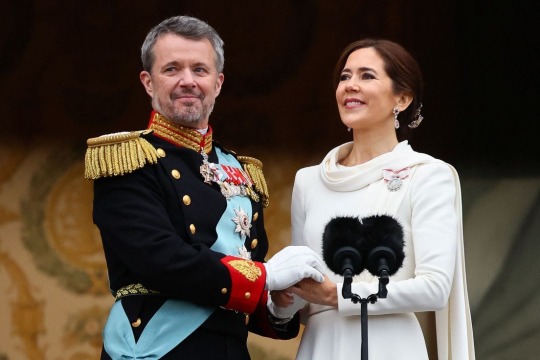
The Crown Princess Mary was crowned Queen consort alongside her husband, the new King Frederik of Denmark. It was a historic moment, for which she wore a historic outfit by the Danish designer Soeren Le Schmidt.
youtube
🎥 credit #dnk.royalty.with.dominik
#MaryDonaldson #Australia #commoner #DanishQueenMary #Queen#Scottishroots #Scotland #Hobart #CockenzieandPortSeton #HenriettaDonaldson #John Dalgleish Donaldson #VikingandNorse #Denmark #Greenland #FaroeIslands #Frederik #KingFrederikX #Tasmania #islandstate
7 notes
·
View notes
Text
D.U.D.E Bios: Odin Rhydderch
The Ogre Duke of C.R.C Odin Rhydderch (2020)

Fionn's son and Rhodri's grandson, Odin. An Irish-Catholic living in Wales and a comedic and creative young man. He's another one of Kirby's first cousins once removed.
"Yeah, beauty isn't everything, for one."
Name
Full Legal Name: Odin Meriwether Hilarius Asmodeus Rhydderch
First Name: Odin
Meaning: Anglicized form of Old Norse 'Óðinn', which was derived from 'Óðr' meaning 'Inspiration, Rage, Frenzy'.
Pronunciation: O-din
Origin: Norse Mythology, English
Middle Name(s): Meriwether, Hilarius, Asmodeus
Meaning(s): Meriwether: From a surname meaning 'Happy weather' in Middle English.
Hilarius: Roman name derived from Latin 'Hilaris' meaning 'Cheerful'.
Asmodeus: From Greek 'Asmodaios' and Hebrew ''Ashmed'ai', probably from Avestan 'Aēshəma' meaning 'Wrath' and 'Daēuua' meaning 'Demon'.
Pronunciation(s): MEHR-i-wedh-er. hee-LA-ree-oos. az-ma-DEE-as
Origin(s): English. Ancient Roman. Biblical, Judeo-CHristian-Islamic Legend
Surname: Rhydderch
Meaning: From the given name 'Rhydderch', from the Old Welsh name 'Riderch', derived from 'Ri' 'King' and 'Derch' 'Exalted'.
Pronunciation: HRUDH-ehrkh
Origin: Welsh
Alias: Ogre Duke Odin Rhydderch
Reason: This is Odin's ring name
Nicknames: Odi
Titles: Mr
Characteristics
Age: 18
Gender: Male. He/Him Pronouns
Race: Human
Nationality: Welsh. Irish-Welsh Mix. Dual Citizenship ROI-UK
Ethnicity: White
Birth Date: December 13th 2002
Symbols: Ogres, Ogresses, Crowns
Sexuality: Heterosexual
Religion: Irish-Catholic
Native Language: Welsh
Spoken Languages: Welsh, Irish, Scottish (Scots Gaelic), English
Relationship Status: Dating
Astrological Sign: Sagittarius
Theme Song: 'Hurt' - Nine Inch Nails (2020-)
Voice Actor: Josh O'Connor
Geographical Characteristics
Birthplace: Llanfaethlu, Anglesey, Wales
Current Location: Llanfaethlu, Anglesey, Wales
Hometown: Llanfaethlu, Anglesey, Wales
Appearance
Height: 6'2" / 187 cm
Weight: 209 lbs / 94 kg
Eye Colour: Blue
Hair Colour: Ginger
Hair Dye: None
Body Hair: Hairy
Facial Hair: Clean Shaven
Tattoos: (As of Jan 2020) 2
Piercings: Ear Lobe (Both)
Scars: Facial scars
Health and Fitness
Allergies: None
Alcoholic, Smoker, Drug User: Smoker, Social Drinker
Illnesses/Disorders: None Diagnosed
Medications: None
Any Specific Diet: None
Relationships
Allies: (As of Jan 2020) The Rhydderch Clan
Enemies: (As of Jan 2020) None
Friends: Isidore Herbert, Napier Rhydderch, Gabriel O'Hannigan, Zayden O'Hannegan, Pacey Rhydderch, Zechariah Rhydderch, Eadberht Rhydderch
Colleagues: The C.R.C Locker Rooms / Too Many To List
Rivals: None
Closest Confidant: Saga Battaglia
Mentor: Fionn Rhydderch
Significant Other: Saga Battaglia (19, Girlfriend)
Previous Partners: None of Note
Parents: Fionn Rhydderch (47, Father), Unity Rhydderch (48, Mother, Née Sauvageon)
Parents-In-Law: None
Siblings: Rachel MacGregor (27, Sister, Née Rhydderch), Queen MacEntire (24, Sister, Née Rhydderch), Pace Rhydderch (21, Brother), Naomh Rhydderch (15, Sister), Macy Rhydderch (12, Sister), Comhghall Rhydderch (9, Brother), Kaiser Rhydderch (6, Brother), Jacinth Rhydderch (3, Sister)
Siblings-In-Law: Bruce MacGregor (28, Rachel's Husband), Coinneach MacEntire (25, Queen's Husband), Urve Rhydderch (22, Fionn's Wife, Née MacEalair)
Nieces & Nephews: Craig MacGregor (7, Nephew), Ceinwen MacGregor (4, Niece), Ceridwen MacGregor (1, Niece), Donald MacEntire (4, Nephew), Dougal MacEntire (1, Nephew), Vilija Rhydderch (1, Niece)
Children: None
Children-In-Law: None
Grandkids: None
Great Grandkids: None
Wrestling
Billed From: Anglesey, Wales
Trainer: The C.R.C Training School, Rhodri Rhydderch, Fionn Rhydderch
Managers: Saga Battaglia
Wrestlers Managed: Saga Battaglia
Debut: 2020
Debut Match: Odin Rhydderch VS Fionn Rhydderch. Double Count Out
Retired: N/A
Retirement Match: N/A
Wrestling Style: Grappler
Stables: The Rhydderch Clan (2020-)
Teams: No Team Names
Regular Moves: Rotating Punch To The Stomach, Backbreaker, Running Knee Lift, Belly To Belly Suplex, Diving Shoulder Block, Dropkick, Gorilla Press, Lariat, Scoop Powerslam, Spinning Spinebuster, Three Point Stance Tackle, Tiger Suplex
Finishers: Boston Crab, Senton, Sitout Gutwrench Powerbomb, High Angle Belly To Back Suplex
Refers To Fans As: The Fans, The Family
Extras
Backstory: Odin Rhydderch of the C.R.C (Welsh Wrestling League / Cynghrair Reslo Cymru) owning Rhydderch family. When Fionn dies Odin will have a 1/432th ownership of the promotion. Odin is an 'Ogre Style' (Grappler) trainer. He's mostly Welsh.
Trivia: Nothing of Note
#D.U.D.E#original character#Rhydderch#C.R.C Wrestling Family#C.R.C Wrestling Promotion#C.R.C Wrestling School
2 notes
·
View notes
Text
SJM's pinterest board. ACOTAR 6/7.
(No conclusion just suspicious stuff lmao)
Here's a photo i found on SJM's ACOTAR pinterest board:
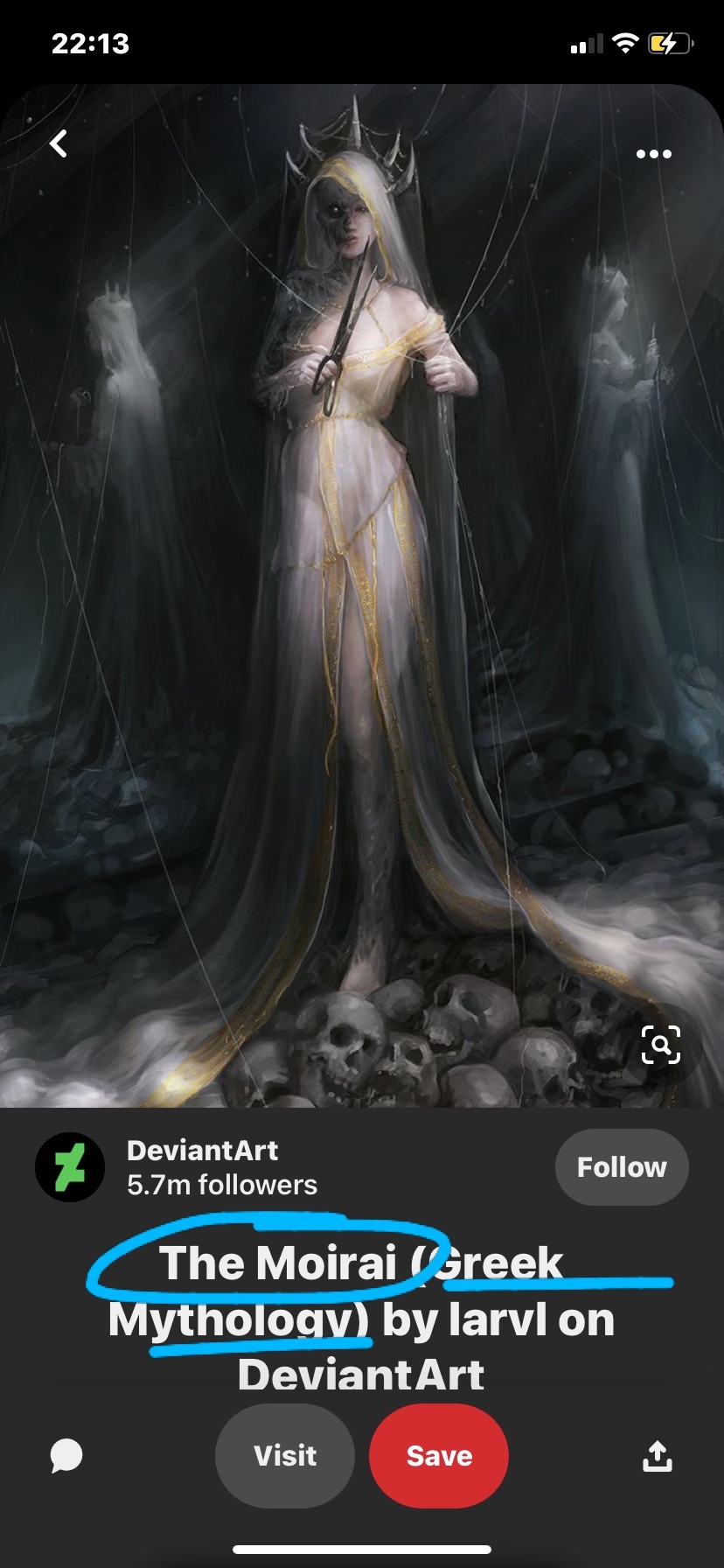
THE MOIRAI (Moirae) were the three goddesses of fate who personified the inescapable destiny of man (and women). The role of the Moirai was to ensure that every being, mortal and divine, lived out their destiny as it was assigned to them by the laws of the universe.
In nearly all mythologies the three Fates, rulers of the past, present and future, are represented and many believe they symbolize the Triple Goddess, Virgin, Mother and Crone (Creator, Preserver and Destroyer).
In Greek mythology, the Moirai—often known in English as the Fates—were the white-robed incarnations of destiny.
“There were at least three dozen priestesses who worked and researched and healed here, though it was nearly impossible to count them when they all wore the same pale robes and so many kept the hoods over their faces.”
Clotho (/ˈkloʊθoʊ/, Greek Κλωθώ, [klɔːtʰɔ̌ː], "spinner") spun the thread of life from her distaff onto her spindle.
(Clotho: the mute priestess at the library)
Lachesis (/ˈlækɪsɪs/, Greek Λάχεσις, [lákʰesis], "allotter" or drawer of lots) measured the thread of life allotted to each person with her measuring rod.
Atropos (/ˈætrəpɒs/, Greek Ἄτροπος, [átropos], "inexorable" or "inevitable", literally "unturning",[13] sometimes called Aisa) was the cutter of the thread of life. She chose the manner of each person's death; and when their time was come, she cut their life-thread with "her abhorred shears". The figure who came to be known as Atropos had her origins in the pre-Greek Mycenaean religion as a daemon or spirit called Aisa. Another important Mycenaean philosophy stressed the subjugation of all events or actions to destiny and the acceptance of the inevitability of the natural order of things; today this is known as fatalism.
The Morrígan or Mórrígan, also known as Morrígu, is a figure from Irish mythology. The name is Mór-Ríoghain in Modern Irish, and it has been translated as "great queen" or "phantom queen".
The Morrígan is mainly associated with war and fate, especially with foretelling doom, death or victory in battle. In this role she often appears as a crow, the badb.[1] She incites warriors to battle and can help bring about victory over their enemies. The Morrígan encourages warriors to do brave deeds, strikes fear into their enemies, and is portrayed washing the bloodstained clothes of those fated to die.[2][3] She is most frequently seen as a goddess of battle and war and has also been seen as a manifestation of the earth- and sovereignty-goddess,[4][5] chiefly representing the goddess's role as guardian of the territory and its people.[6][7]
Mor may derive from an Indo-European root connoting terror, monstrousness cognate with the Old English maere (which survives in the modern English word "nightmare") and the Scandinavian mara and the Old East Slavic "mara" ("nightmare");[14] while rígan translates as "queen".[15][16] This etymological sequence can be reconstructed in the Proto-Celtic language as *Moro-rīganī-s.[17][18] Accordingly, Morrígan is often translated as "Phantom Queen".[16] This is the derivation generally favoured in current scholarship.[19]
The Morrígan is often considered a triple goddess, but this triple nature is ambiguous and inconsistent. The triple appearances are partially due to the Celtic significance of threeness.
(Three is a VERY common number in acotar (might make a whole other post on that))
Could Mor be one of the fates or even something more powerful than them, could she have a bigger part than we thought in the next story with Koschei ?
In the Republic of Plato, the three Moirai sing in unison with the music of the Seirenes. The term "siren song" refers to an appeal that is hard to resist but that, if heeded, will lead to a bad conclusion.
In Greek mythology, the Sirens (Ancient Greek: plural: Seirênes) were dangerous creatures, who lured nearby sailors with their enchanting music and singing voices to shipwreck on the rocky coast of their island. It is also said that they can even charm the winds.
i bet your thinking where tf is this looney going with this....well,
i also found this photo:

Celtic Mythology The GWRAGEDD ANNWN [wives of the underworld]were lake-sirens in Wales. These lovely creatures are known to choose mortal men as their husbands. One legend has it that they live in a sunken city in one of the many lakes in Wales. People claim to have seen towers under water and heard the chiming of bells. In earlier times, there used to be a door in a rock and those who dared enter through it came into a beautiful garden situated on an island in the middle of a lake. In this garden there were luscious fruits, beautiful flowers and the loveliest music, besides many other wonders. Those brave enough to enter were welcomed by the Gwragedd Annwn and were invited to stay as long as they wanted, on the condition that they never took anything back from the garden. One visitor ignored the rule and took a flower home with him. As soon as he left the island, the flower disappeared and he fell unconscious to the ground. From that day on, the door has been firmly closed and none has ever passed through it again.
“My grandmother was a river-nymph who seduced a High Fae male from the Autumn Court.”
Gwyn believes her grandmother to be a river-nymph. Is it possible that she was not but instead a lake siren? We know that Gwyn and Catrin's names are welsh (Lake-Sirens are found in wales) and the spring court has many ties to welsh mythology so is it really that far fetched?

In Celtic and Norse mythology, selkies (also spelled silkies, sylkies, selchies) or selkie folk (Scots: selkie fowk) meaning "seal folk"[a] are mythological beings capable of therianthropy, changing from seal to human form by shedding their skin. They are found in folktales and mythology originating from the Northern Isles of Scotland.
To further back up this, here is another photo of a Selkie woman on SJM's pinterest.
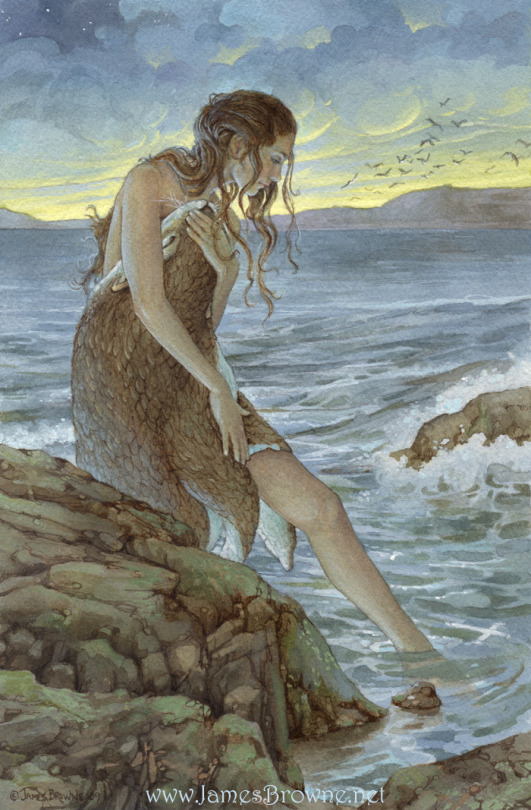
In David Thomson's book The People of the Sea, which chronicles the extensive legends surrounding the Grey Seal within the folklore of rural Scottish and Irish communities, it is the children of male selkies and human women that have webbed toes and fingers. When the webbing is cut, a rough and rigid growth takes its place.
Children born between man and seal-folk may have webbed hands, as in the case of the Shetland mermaid whose children had "a sort of web between their fingers",[25] or "Ursilla" rumoured to have children sired by a male selkie, such that the children had to have the webbing between their fingers and toes made of horny material clipped away intermittently.
“My twin had the webbed fingers of the nymphs—I don’t.”
Once again we see that Catrin posses traits of these water-creatures.
Keep in mind SJM has this on her board - The cover of Celtic folktales which has one story in particular of a 'sea-maiden' whom makes a deal with a mortal man.
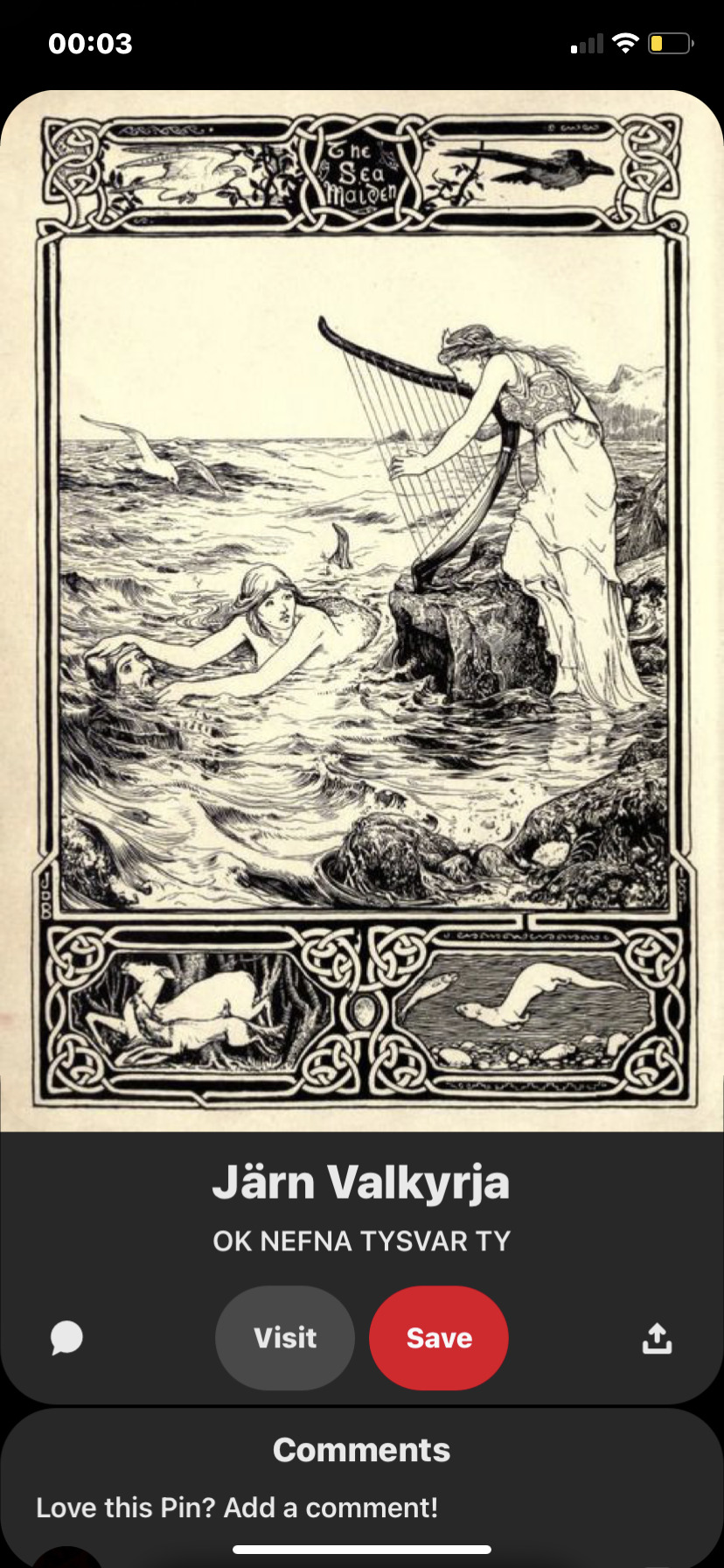
I proceeded to continue searching through the board and found this:
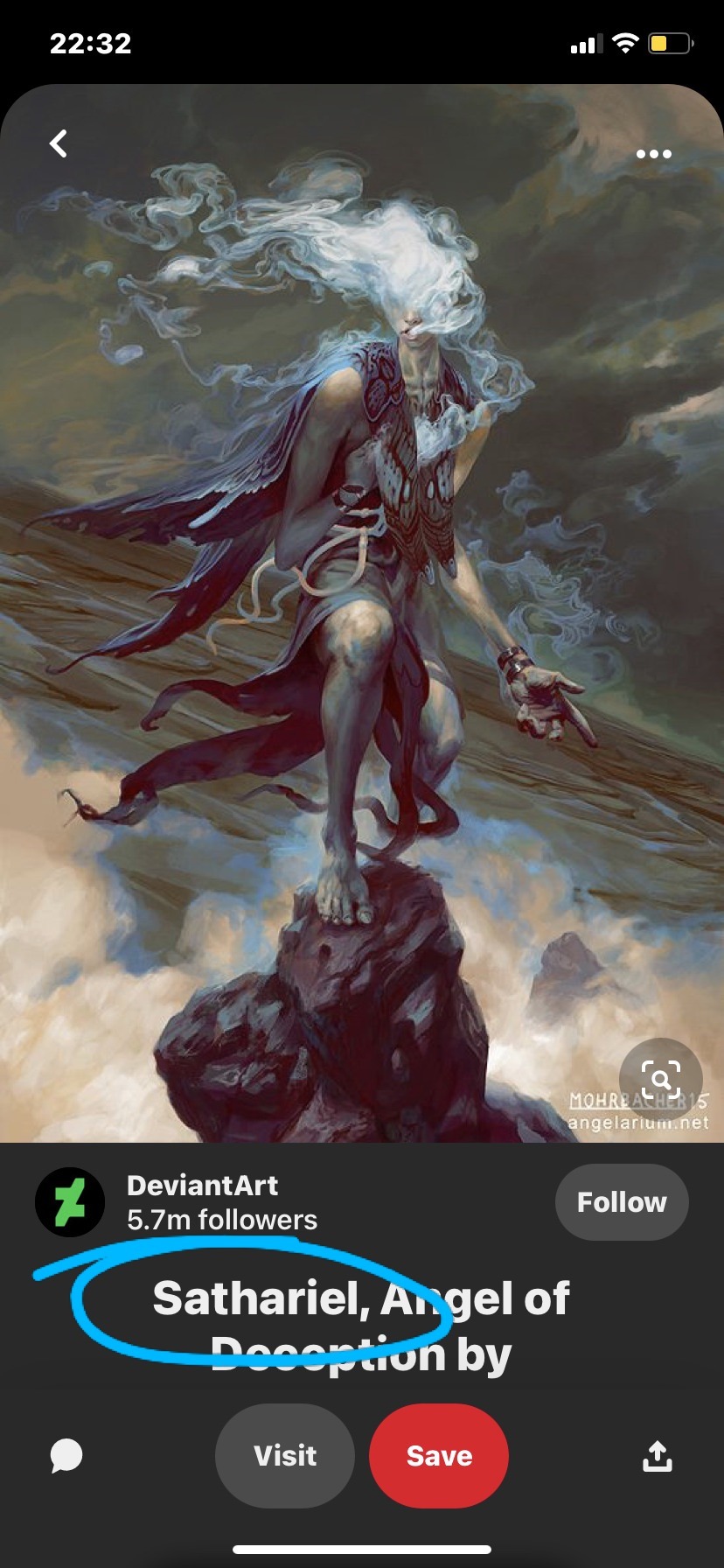
Sathariel (Hebrew סתריאל, Greek: Σαθιήλ) is one of the Qliphoth, corresponding to the Sephirah Binah on the kabbalistic Tree of life. It represents the Concealment of God, which hides the face of Mercy. The form of the demons attached to this Qliphah are of black veiled heads with horns, with hideous eyes seen through the veil, followed by evil centaurs.
'veiled heads with horns'
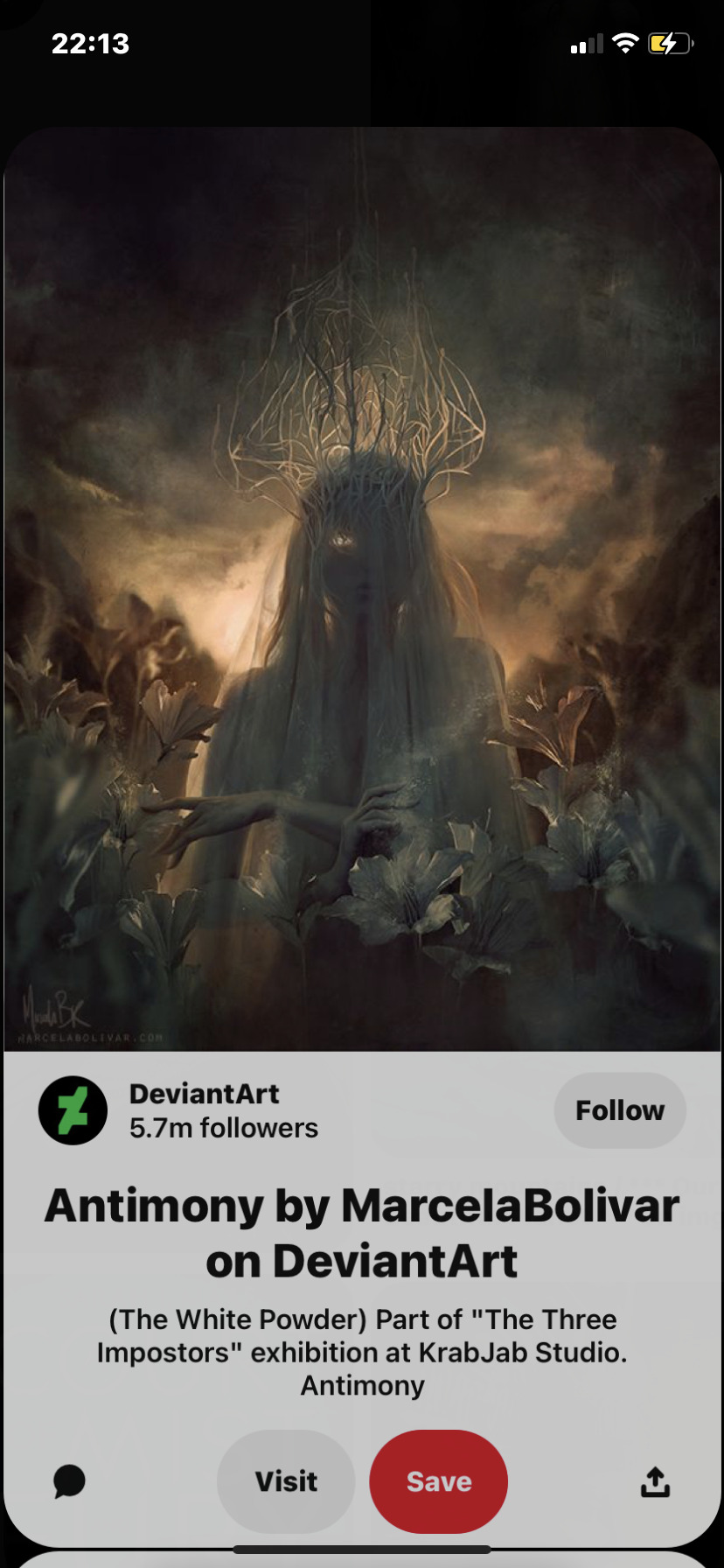
The Qliphoth are the shadow of the Sephirot, the chaotic force that exists when the Sephirah is unbalanced. Binah is the Sephirah that gives birth to form, the great mother of the cosmos, the eternal womb. Through her, the spiritual energy of Keter and Chokmah are woven into the matrix that eventually becomes matter.
In Jewish Kabbalistic cosmology of Isaac Luria, the qlippot are metaphorical "shells" surrounding holiness. They are spiritual obstacles receiving their existence from God only in an external, rather than internal manner.
Quiphoth (shadow of sephriot) = Shadowsinger
"shells" surrounding holiness = The shadows protected Azriel
They emerge in the descending seder hishtalshelus (Chain of Being) through Tzimtzum (contraction of the Divine Ohr), as part of the purpose of Creation.
Sathariel had black feathers on his wings and his body was shrouded in darkness.
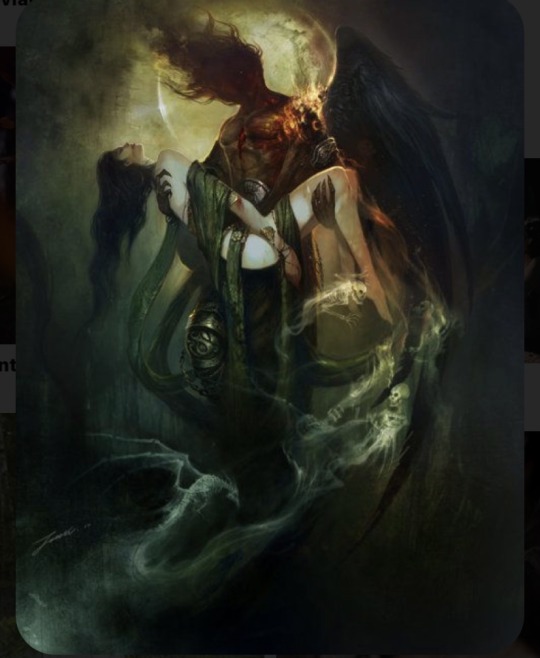
Honestly idk where tf im going with this 😩😩
I've put in far too much effort to delete it so i apologise if you've gotten all this way to be disappointed but
Conclusion:
Mor =/≠ Three fates
Gwyn = Heritage is sus? could be related to some interesting people
Azriel = Sathariel ?
If anyone has ideas to add pleaseeee tell me lol
i'll probably update this when i can be bothered
(FYI i love Gwyn and i'm not saying she's a siren or luring anyone but you've got to admit her grandmother is a sus lmao, especially with half the shit on SJM's pinterest.)
#i have not slept#this makes zero sense#acotar#azriel#azriel x gwyn#gwynriel#gwyneth berdara#azriel berdara#morrigan#acotar theory#acotar 6#acowaf#acomaf#acofas#acosf#a court of frost and starlight#a court of mist and fury#a court of silver flames#a court of wings and ruin#a court of thorns and roses
83 notes
·
View notes
Note
Quick question, what’s the difference between an elf, faerie and fairy. - confused follower
A good question, cause it’s not at all a clear distinction! As far as my amateur folklorist understanding goes:
Elves (singular elf) originally come from Germanic and Nordic folklore. They were generally very humanlike only more beautiful and more powerful, partly because they were closer to nature than humans. However, as time went on the word “elf” and words like them, like “alf” and “elfje”, were also used to describe smaller magical creatures. Much like the English word “fairy”.
Fae, faerie and fairy are basically all the same word, just transformed over time. Hidden creatures capable of magic are addressed with fae, fee, fay, fate or something like it all over Europe, but the ones we see most in modern media were inspired by Celtic (and English) folklore. There never was a clear definition of what these terms meant. Fae or fairies could be large or small, live in groups or alone, be helpful of malevolent, be powerful or quite weak. It’s an umbrella term, really. When English speakers encountered folklore from other cultures, they often used the same words to describe these new creatures as well. And so we ended up with an incredible range of creatures that are called fae. Nowadays you tend to see “fairy” for small creatures and “fae” for human-sized, more powerful creatures, but not everyone follows this. Using “faerie” instead of “fairy” is just walking the etymology of the word back a bit towards its origins.
Now things get extra confusing, because of course the Nordic, Germanic and Celtic traditions did mingle. The Irish, Scots, Welsh and Cornish all had their own ideas about fae that seemed nearly human or could appear so if they liked. The Irish tradition talked of great warriors, the Scots had their faerie courts and the English talked of hunting parties. This fit rather well with the idea of the “dark elves” (Dökkálfar) and “light elves” (Ljósálfar) as they appeared in Norse mythology. At the same time later Scandinavian folklore talked of elves playing in the moonlight, living in mounds of stones and dancing at balls given by the elven king. Which is awfully reminiscent of the various Celtic fae. So it’s no wonder elves and fae started to blur together a bit. (Not to mention lumping trolls and changelings in with fae as well.)
By the time Tolkien (who was wild about Nordic mythology) made his elves, he had plenty of crossover to choose from. I am sure whole dissertations have been written on his elves, but suffice to say that his version by no means covers all elvish characteristics, but does form the basis of what most people nowadays think of as elves. How we think about fae and fairies, however, seems to mostly refer back to Shakespeare’s A Midsummer Night’s Dream. Now I’m definitely not going down that literary rabbit hole, but he definitely put a lot of English varnish on Scottish faerie courts.
To step away from the English-speaking world – and make things even more difficult – in some places “fae” are a bit more ethereal and elves a bit more earthy. When you encounter a fée in France, a fate in Italy or a fee in the Netherlands, they could be small or human-sized, but they are probably clad in fluttery garments, maybe even give off light, and can appear at will. Little elves, however, as encountered in the Netherlands for instance, may be found fluttering about with tiny wings and drinking the water left in toad stools. They might lead someone astray in the woods at times, but they won’t be kidnapping or enchanting anyone. We have those creatures too, but we call them by different names.
And that is the true trouble of elves, fae and fairies. By now so many different types of creatures are called that in English, that the term is of very little help! I am always a fan of finding the local term for a creature and using that instead. Because while in literary works “elfin knight” or “fairy queen” was usually good enough, local folklore often does have specific terms for different types of creatures!
#fae#faerie#fairy#folklore#anon#ask#answered#laura babbles#I /tried/ to keep this short#I failed a bit#Anonymous
67 notes
·
View notes
Text
Rating movies & shows about historical events that have little to nothing to do with the UK or North America but are a UK/American production for whatever reason
Reign (US, 2013 – 2017)
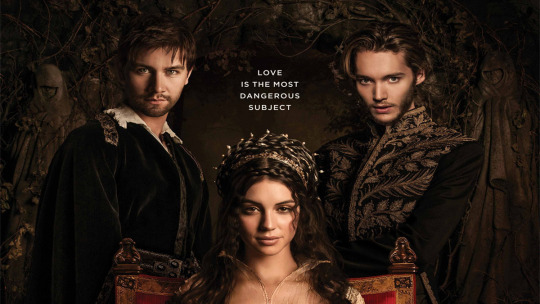
Focuses on Mary, (not quite) Queen of Scots, and her upbringing in France ca. 1557. I know very little about Mary, but enough that watching this show made my skin crawl. It’s honestly just an excuse for the CW (derogatory) to produce a ~steamy romance~ with a lot of mother-in-law drama and baiting you into sorting the primary love interests into the good boy/bad boy dichotomy, then it goes sike!, it’s actually the other way around, lol. That’s the cleverest it gets, really. The costume design is infamously horrendous. Whatever happened to the court ladies is just plain out wrong and I only skimmed the Wikipedia article on them about six years ago. Also everybody speaks British English even though they’re in France, even though the show is about Mary getting thoroughly baguette’d. What is an irony? Points for Catherine de’ Medici who’s played by Megan Follows and therefore automatically stanned by me because she starred in Anne of Green Gables once about 35 years ago. 3/10.
Marco Polo (US, 2014 – 2016)

“Inspired by Marco Polo’s early years in the court of Kublai Khan, the Khagan of the Mongol empire and the founder of the Yuan dynasty […] produced by The Weinstein Company […]”. I honestly got very very bad goosebumps when I read the synopsis for several episodes. This is a story about the Mongols who founded an important Chinese dynasty, and therefore the casting of several Chinese-(American) actors among Malaysian and Korean ones seems fine, but it sucks that there doesn’t seem to be single actor with Mongolian ancestry in it, especially when famous Mongolians are depicted. Points for Netflix actually casting an Italian actor as Marco Polo, the bar is so low, but I’m so impressed. Also points for this show making The Weinstein Company suffer a big financial loss. 2/10.
Vikings (Ireland/CAN, 2013 – )

“Inspired by the sagas of Viking Ragnar Lothbrok, one of the best-known legendary Norse heroes and notorious as the scourge of England and France.” My friends love this show, I’m bored by it. I haven’t watched more than two episodes and a few scene compilations. It doesn’t seem to be too far off even though the word “inspired” makes my alarm sirens go off, and I’m not exactly happy about the showrunner going “well, we don’t know for sure what happened, so I made a show about history but I changed bits so they it would be cool enough for the broader audience who doesn’t give a fuck about historical accuracy.” The earlier seasons also didn’t give a fuck about casting Scandinavian actors. I was glad to spot George Blagden though, who did a good job on Versailles. And they do have a cool intro. 5/10.
Versailles (CAN/F/UK/US, 2015 – 2017)
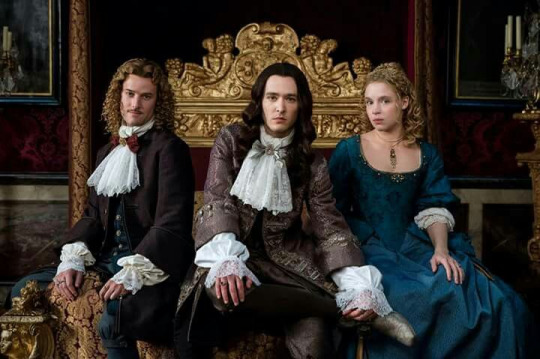
Takes place during the construction of the palace of Versailles and during the reign of a rather young Louis the XIV, also known as the Sun King. I have no idea what happens in this, because I came for the actual palace of Versailles and suddenly it was about everything but. I would honestly watch a drama about draining swamps, but no. I eventually ended up watching the whole show simply for two chaotic gays who have to enter a polyamorous business relationship with a German princess, which was an interesting and challenging dynamic, and has some historical facts at its core. Everybody speaks British English even though again, we’re in France. 6/10.
Troy (UK/US/Malta, 2004)
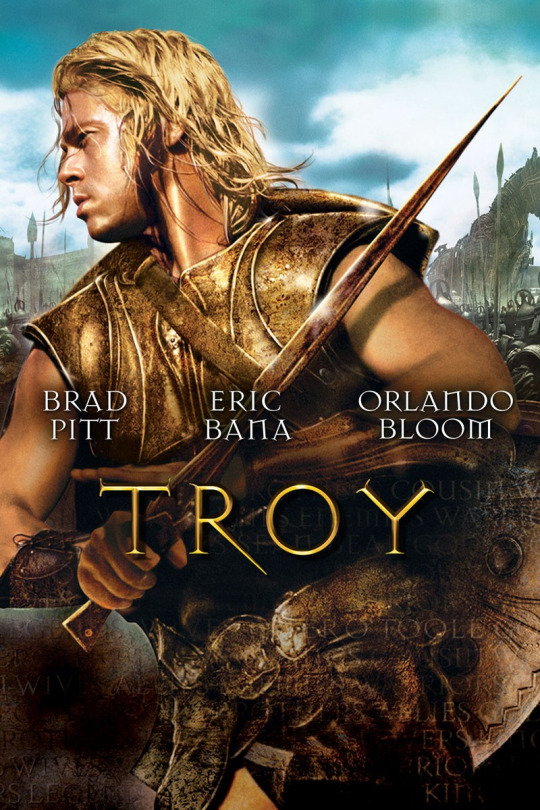
About the Trojan War. Stars lots of Americans but no Greeks. I don’t care much about heterosexual takes. 4/10.
Schindler’s List (US, 1993)

Focuses on Oskar Schindler, a German-Moravian industrialist who helped about 1200 Jewish people to escape the Holocaust during World War 2 by calling them “essential workers”. We get it, Americans love hero stories (as you can see on that movie poster, sigh). Unfortunately, Schindler isn’t that well-suited for the hero persona. He did take big risks, but he also profited from “keeping his Jews”; his memory pales in comparison to other people who weren’t even nearly as privileged as he was and risked much, much more. The ending scenes sucked ass. Mainly starring English speakers in German roles and Ben Kingsley as Itzhak Stern, a Polish Jew. Ben Kingsley also starred as German-Jewish Otto Frank in an Anne Frank adaptation. No comment. 4/10.
Suite Française (UK/France/Belgium, 2015)

Based on Irène Némirovsky’s story about a Frenchwoman who’s estranged from her husband and her houseguest, a German officer and mysterious stranger, who fall in love during the Nazi occupation of France. Irène was a French writer of Ukrainian-Jewish origin who was murdered in the Holocaust before she could finish the story. The story is haunting, complicated, simmering with tension and good context, very well-made. However, everyone in this movie speaks British English, again - and in this case, it seems even more rude than in the other movies/shows. Bear in mind that this isn’t only a doomed, problematique ™ love story, but also a story about German-French relations. German and French people hate each other at this point because of their massive 1000-year-baggage, but they’re deeply intertwined. The adaptation could’ve involved undubbed German/French and included subtitles depending on whether the scene was about being understood or not; they could’ve demonstrated who speaks the others’ language very well (subs) or not at all (no subs). They could’ve emphasized body language for example, which could’ve been great in terms of the budding affair. This could’ve demonstrated the movie’s message and the German-French conflict in very powerful ways. Not to forget that stories like these often resulted in terrible treatment of those who chose (or were forced!) to be friendly with the enemy, which is a very sensitive topic in post-World War Europe and should be handled as such, by European actors, in my opinion. This is a vital thread in their historical fabric. TL;DR: This movie should’ve been handled by the German-French public TV channel ARTE, they would’ve rocked it. Instead, they chose US-American Michelle Williams to be the French protagonist, and Matthias Schoenaerts (Belgian) to be the German protagonist. Supporting roles were partly played by German actors, but they were made to speak English as well. Movie barely gets saved by the score and the overall story. 6/10.
The Great (US, 2020 - )

Loosely based on the rise of Catherine The Great, Empress of All Russia. This is a black comedy/satire, and it’s very important to keep this in mind. The show knows it’s balls to the walls and a historian’s nightmare, but its intended audience are drunk historians getting high on Elle Fanning and witty writing, and that’s where it succeeds. Nicholas Hoult as Emperor Peter is a revelation. Again, everybody speaks British English even though Catherine is German, the story takes place in Russia, and the most popular language among the characters would most likely be French. None of the cast is German or Russian – we’re noticing a pattern. I developed an embarrassing crush on Sacha Dhawan as Count Orlo who was supposed to be ugly but turned out to be ugly-hot. Watch it. 8/10.
#you're super welcome to make additions for chernobyl or the death of stalin or whatever#contrary to popular belief i haven't watched every historical show on this earth#and i probably forgot some of the ones i know#history
11 notes
·
View notes
Note
If you don't mind answering, what are some things that you really, really wish you'd see more of in depictions of medieval Scotland/Early Modern Scotland?
I absolutely don’t mind answering, thank you for asking!
I’m told there are some better quality novels than there are tv shows and films, so there are some aspects that have been done in good novels (though I’m not so familiar with them). There are so many things though that could be done on screen:
- Chiefly I spend a lot of my time wishing that there was more attention paid to the actual geographical make-up of Scotland and its regional variety, e.t.c beyond just splitting everything into Highland/Lowland, or just portraying everyone as being part of a Clan in the Highland sense, or just sticking everyone in Edinburgh as if that was the only place where anything happened. Orkney was very different to Galloway, and the Borders were very different to the Western Isles, and Ross was different to Aberdeenshire.
Now if this was true for the sixteenth century, it is even MORE true for the eleventh, twelfth, and thirteenth centuries. Between the early Middle Ages and the end of the thirteenth century, Scotland was settled by a lot of different cultures- so in the twelfth century for example, much of the country (the traditional heartland of ‘Scotia’ north of the Forth) may have spoken Gaelic but Lothian had been settled by speakers of Old English some centuries ago and their language became Scots in time, and spread north of the Forth into Fife, Angus, Aberdeenshire and elsewhere so that by the sixteenth century it was much more widely spoken and the language of government. The south-west, especially the area around the Clyde and Glasgow was a British kingdom for a long time, speaking a language not dissimilar to Old Welsh- this kingdom had (sort of) disappeared by the mid-twelfth century but the language took a while to completely disappear. Up in Orkney, Shetland, and Caithness, rather like in Iceland and the Faroes, Norse settlers had taken over and Norse culture has still left traces there today. From the fourteenth century, Scots began to take over in the Northern Isles but there was still a very clear Norse background in the sixteenth century. Meanwhile in the Western Isles, the Norse newcomers did not manage to erase Gaelic so completely as they did in the Northern Isles, but they did leave their mark on the Hebrides, to the extent that the inhabitants in the Western Isles in the in the twelfth century were descendants of both cultures- they are sometimes called Gall-Ghàidheil in Gaelic, meaning ‘foreigner Gael’. Then over the course of the twelfth century more new immigrants moved in. The ranks of the nobility were swelled by Norman, Breton, and other French settlers- unlike England, there was no ‘Norman Conquest’, and the process was more gradual, but although the French language never had the same power in Scotland as it did in thirteenth century England, these settlers left their mark on the feudal system and other aspects of Scottish society, and in turn they too were affected by the cultures they encountered in Scotland. Other smaller pockets of immigration existed- immigrants from Flanders and the Netherlands, for example, were instrumental to developing Scottish towns and improving agriculture. In the east coast burghs of Fife and Lothian you can still see some architectural elements that may have been the result of trade with the Dutch- crow-stepped gables and red pantiles for example.
Although most of these cultures have altered and changed by the sixteenth century, the fact remains that the cultural backdrop to fourteenth or fifteenth century Scotland was a real mix- Gaelic, English, French, Norse, Flemish, British- and, perhaps, whatever it was that the elusive Picts left behind beyond their wonderful stone monuments. I have perhaps oversimplified things here but the point is that mediaeval and early modern Scotland was not a cultural monolith- something which both Scottish and foreign film-makers would do well to remember.
There are also changes to these regions across the years- Orkney going from being a Norwegian/Danish territory to becoming part of the Scottish kingdom, or the borders which had some of the best farmland and richest abbeys in the country in the thirteenth century becoming a very militarised and rather lawless zone after the Wars of Independence. I think it would be really interesting to see that portrayed on screen.
- Ok so that was the fundamental thing, apologies for the rant. But to go with that, more understanding of the landscape and architecture. In all fairness most tv shows and films involving Scotland, no matter how bad they are, at least have some lovely panning shots of the Highlands but there’s more to the country than Glencoe- you could really work with views like the sun on the sea from the Carrick coast or the beautiful if ruinous religious architecture- like the abbeys of Melrose or Arbroath or somewhere like Elgin Cathedral or Rosslyn Chapel or Inchmahome Priory.
- Costuming! Again this fits into the regional thing a bit, but it’s also more general. It’s a quibble I have with almost any medieval media but especially when it comes to Scotland people get really lazy with the costuming and just slap some shortbread tin stuff together rather than putting any thought into it.
- More traditional music! A surprising number of ballads and songs that are still popular among folk singers today are thought to have their roots in early modern if not mediaeval Scotland. And again the musical heritage of Scotland is varied depending on the culture it comes from.
- More properly developed female characters. Even though half the historical films made about Scotland are about Mary Queen of Scots, there are almost no good depictions of historical Scotswomen- and that’s NOT because there aren’t any interesting women in Scottish history before the modern period! There are lots of fascinating women’s stories from mediaeval and early modern Scotland, and although we are often frustrated by a lack of sources, we know they were there. More importantly, even if every woman was not a Certified Bad-Ass, as a whole women in Scottish history are not invisible and we can often see them in the records, whether operating in domestic, business, religious, or political contexts. Oddly, in their quest to show how Uniquely Misogynistic and Evil the Scottish nobility were to Mary Queen of Scots or Margaret Tudor or whoever, film-makers often end up ignoring women’s stories and therefore perpetuating the sexist view of history they claim to hate. (Though, yes mediaeval and early modern Scotland WAS misogynistic- but show me a country that wasn’t. Also it was misogynistic in a slightly different way to some other countries). I could list off dozens of interesting Scotswomen who lived before 1603- even though we sometimes can’t tell that much about their inner lives from the surviving sources, it’s obvious they were of some importance. And again it fits back into the cultural variety thing, because that was not limited to Lowland, Scots-speaking noblewomen.
- More art and literature and architecture and education and music and EVERYTHING. Scotland lost a LOT during the Reformation and due to Anglo-Scottish warfare (that’s what happens when the main centre of your kingdom is near to a border). But we know that, though it was sometimes an out of the way place, Scotland could be just as heavily tied into European cultural trends as any other northern country. And there are some beautiful surviving cultural artefacts that hint at a more vibrant past- both produced in Scotland (in the Gaelic and Scots-speaking environments) and imported from abroad.
- Equally on that note, more focus on its connections to countries other than England. Scotland had three universities by 1500, and yet many Scottish students still went to study abroad, especially in France, but also in England, the Low Countries, Italy, and elsewhere. An Italian humanist taught at the Abbey of Kinloss away up in Moray in the sixteenth century, and Scottish thinkers were in touch with other great minds of the day. Scots also fought abroad (see mercenaries in Sweden, or James IV’s support given to his uncle the king of Denmark, or the Garde Écossaise), and traded heavily across the North Sea (there were multiple Scots merchant colonies on the continent, not least at Veere). Scotland’s relations with Norway, Denmark, the Low Countries, the Papacy, Ireland (both as part of the kingdom of England and with individual Irish families), and other countries could be almost as important as its relationships with France and England. The eternal triangle of Scotland, England, and France, was not actually always the story- there were occasions when England and France played very little role in Scotland’s foreign affairs, let alone its domestic history.
- In particular an acknowledgement of the high quality of Scots poetry in the late fifteenth and early sixteenth centuries wouldn’t go amiss.
- This is one which applies to all mediaeval media- but a more varied and interesting depiction of mediaeval religion would be good. In Scotland, this was also linked to the way people saw their own history- any sixteenth century Scot would have known some of the native saints, and anyone half-educated might have heard the names of David I and St Margaret and Columba, and known where the great abbeys in the kingdom came from.
- Actually a basic knowledge of Scottish history and legends beyond a few famous names. For example family was important in noble society- just because the stereotypical The Clans Are Gathering model is massively inaccurate, doesn’t mean that noble families in Scotland didn’t care about ancestry and kinship. But it would be great if tv shows and movies could actually think about how to portray that- and it really shows how little some of these scriptwriters know about their characters when they’re supposedly obsessed with the honour of the clan but the only piece of their country’s history they know is the name William Wallace. If you’re portraying the Douglases- even the earls of Angus who weren’t directly descended from him- the legacy of Sir James Douglas would have been a source of some pride. For actual ‘clans’, you could be dealing with some of the clans in the west of Scotland who, like some families in Ireland, claimed descent from Niall of the Nine Hostages. Some family histories got warped along the way- the Stewarts, for example, seem to have forgotten that they were descended from a Breton named Flaald by the fifteenth century and instead latched onto a story involving a character named Fleance (the one who later appears in Macbeth). As for legends- you could have a lot of fun with the different kinds of fairy belief that existed in Scotland, from the Borders (where it inspired ballads like Tam Lin) to the Highlands, or you could bring up legendary figures that are shared with other countries like King Arthur or Fionn Mac Cumhaill or Robin Hood or Hector of Troy. Sometimes the legends even cross over into real life- Thomas the Rhymer, hero of ballads and fairytales, seems to have been based on a real person who lived in the reign of Alexander III; while stories about William Wallace and Robert Bruce often became folk tales in the tradition of other greenwood outlaws like Robin Hood.
I think it’s pretty evident that my main issues with depictions of mediaeval and early modern Scotland on tv and film are largely because it’s so utterly unlike anything I see in the historical record. I’d love to list specific details and characters I’d like to see portrayed on screen, but before we even get to that point, the whole Generic Portrait of Scotland needs to change, because it doesn’t currently feel very realistic or interesting. All I really want is for the same level of research to be done with regard to Scotland as is done for England or France or any other country- England is often portrayed inaccurately, but there’s still at least 200% more effort put in than for Scotland.
On that note though, James I’s career (or at least the early fifteenth century as a whole) has been ripe for a television adaptation for years. Also I’m personally fascinated by ordinary rural life, patterns of agriculture and landholding, e.t.c. so even just an ordinary story set in an early sixteenth century fermtoun would be cool. But I don’t really think these stories would make any sense to people if Scotland was just portrayed the way it usually is - a generic country with no culture beyond a few scraps of tartan and alcohol and Anglophobia.
Thank you for the opportunity to rant, and apologies for the screed! I couldn’t express my enthusiasm very concisely I’m afraid. I genuinely don’t mind if there’s some inaccuracies to portrayals of Scotland, but now all portrayals are exactly the same and almost wholly inaccurate so it gets frustrating.
16 notes
·
View notes
Text
IRELAND’S TOP 10 STRANGEST PLACENAMES
FOUND HERE: https://www.spookyisles.com/ireland-strange-place-names/
WHAT STRIKES ME IS THE DEMONISING OF IRELAND’S PAGAN PAST BY THE CHURCH.
WELL, THAT WAS THEIR “JOB” I S’POSE, BACK IN THE DAY. HERE’S ONE EXAMPLE:
“ Queen Maeve’s Vulva, County Antrim The townland of Ballypitmave is said to be the place where the Irish demi-god Queen Medb of Connacht stole a prize bull and finished her years after murdering her sister and nephew. It is said the menstrual flow of the fertility goddess carved channels into the landscape of County Down and County Armagh. It leads to a burial chamber on Cairn Hill which is said to be a portal to Hell itself.“
NOTE, THE BURIAL CHAMBER DOESN’T DO WHAT, SAY, HOLLOW HILLS AND MANY BURIAL CHAMBERS LEAD TO IN MY NATIVE SCOTTISH HIGHLANDS...TAKE YOU TO THE LAND OF THE SIDHE, THE FAE FOLKS. NOPE. IT GOES TO “HELL”.NOT ONE “L”. (SORRY, WEE NORSE HEATHEN REF THERE)
THEN THERE’S THIS PLACE:
“A hiker’s paradise, this delightful walk leads to an enchanting waterfall, which in bygone years, sounded like a Lucifer-esque roar from the pits of Hades.“
SOMEONE GIVE ME THE NAME OF *ANYONE* WHO EVER HEARD LUCIFER ROAR? GO ON, PLEASE.
I LOVE IRELAND. IT HAS IT’S QUIRKS LIKE ANYWHERE ELSE. BUT SINCE I GOT HERE, DESPITE THE FACT IT IS OBVIOUSLY A CHRISTIAN ISLAND, THE LANDSCAPE HERSELF HAS REMAINED, IMO, THOROUGHLY PAGAN. AND SHE REMEMBERS WHO SHE IS JUST FINE.
LANDSCAPES DON’T MUCH CARE WHAT HUMAN LABELS ARE PUT UPON THEM. LANDSCAPES KNOW THEY’LL CONTINUE TO EXIST ONCE WE’VE PUT OUR BONES INTO THE SOIL OF THEM AND NOURISHED THE LAYERS THAT MAKE UP THE PASSING OF TIME.
AS A CHILD IN THE HIGHLANDS OF SCOTLAND, I HAD THE LUXURY OF BEING ABLE TO RUN FREE IN THE REMOTE AREA WE LIVED. NOW, I REALISE HOW LUCKY THAT WAS. BACK THEN IT WAS SIMPLY NEGLECTIVE PARENTS WHO DIDN’T GIVE A F*CK WHAT I DID OR WHERE I WENT OR EVEN WHEN I GOT INTO BED AT NIGHT.
SO I ROAMED. I REMEMBER MAKING IT A QUEST OF MINE TO FIND PLACES I BELIEVED NO HUMAN FOOT HAD EVER TRODDEN.
BELIEVE IT OR NOT, EVEN TODAY IN THE HIGHLANDS, YOU *CAN* STILL DO THAT....THERE *ARE* PLACES, HARD TO REACH BUT STILL THERE, WHERE NOBODY EVER PLACED A FOOT.
IN MY CHILD’S MIND, I DID IT BECAUSE, AS A HEATHEN BAIRN, IT WAS MY WAY OF TRYING TO CONNECT WITH THE EARTH BENEATH MY FEET.
ONE OF THE MEMORIES I’LL CARRY WITH ME TO MY CREMATION (NO BURIAL, THANKS) WILL BE THAT OF SITTING UNDER A TREE ON A WINTER’S DAY, THICK SNOW ALL AROUND ME AND THAT BEAUTIFUL BLANKET OF SILENCE YOU GET WITH IT. I’D BEEN LONG WALKING AND WAS TIRED. SO I SAT DOWN, HAD A FLASK OF COFFEE AND JUST LOOKED AROUND ME, NOT THINKING OF ANYTHING MUCH.
IN THAT SILENCE, A SOFT FLURRY OF WINGS. A BLURR OF WHITE AND SHEEN OF LARGE ROUND EYES, GLIMPSE OF LONG, CURVED BLACK TALONS, AND A BARN OWL HAD MADE OFF WITH A MOUSE THAT’D RUN OUT OF A HOLE BENEATH A NEARBY TREE.
IT WAS OVER IN AN INSTANT. SO I WALKED TO WHERE IT’D HAPPENED. IN THAT PATCH OF PRISTINE SNOW THERE WAS ONE TINY RED SPLOTCH OF MOUSE BLOOD, SURROUNDED BY THE PERFECT OUTLINE OF OUTSTRETCHED OWL WINGS. NOTHING ELSE. NO CLAWS HAD TOUCHED SNOW, EVEN THE MOUSE’S FOOTPRINTS WEREN’T VISIBLE. JUST THAT JEWELLED DROP OF BLOOD SURROUNDED BY THE IMPRINT OF FEATHERED WINGS.
BACK IN THOSE DAYS, WE DIDN’T HAVE DIGICAMS, SMARTPHONES OR THE LIKE. EVEN IF I DID (AND POVERTY MEANT I WOULDN’T HAVE) I COULDN’T HAVE BEEN QUICK ENOUGH TO TAKE THE PICTURE.
SO I RELY ON MY MEMORY TO KEEP THAT PARTICULAR “PHOTOGRAPH” ALIVE FOR ME.
THE PLACE I WAS SITTING, WELL, THE NEAREST TOWN WAS THURSO, QUITE SOME MILES AWAY BUT THE NEAREST NAMED PLACE OF HABITATION.
THOR’S PLACE.
MY GRAN, A DYED IN THE WOOL HEATHEN, ONCE TOLD ME TO RESPECT THE LAND. SHE WAS ONE OF THOSE OLD SCOTS GRANNIES WHO WOULD CHEERFULLY CLOUT COMPLETE STRANGERS ROUND THE LUG (EAR) FOR DROPPING LITTER, FEARLESS SHE WAS.
SHE TOLD ME THERE ARE OLDER, WILDER GODS THAT SLEEP AND STILL WALK THE LANDSCAPE THAN EVEN THE NAMED ONES WE REMEMBER. THE CELTS KNEW THAT. THE NORSE KNEW THAT, AS DO THE SAAMI AND THE STEPPE TRIBES.
I LIVED, TOO, A LONG TIME ON A SMALL ORKNEY ISLE. THE NAMES THERE OFTEN REFLECTED THE CHRISTIANISATION OF THE PAGAN LANDSCAPE TOO. “HELL’S WYND” IN STROMNESS, FOR EXAMPLE. “GALLOW HILL” WHICH KIND OF SPEAKS FOR ITSELF. THEN THE ON THE NOSE NAME OF “HELL”....BUT PERHAPS THE MOST FAMOUS ORKNEY NAME IS THE ONE WHOSE SIGN IS ONE OF THE MOST STOLEN FOR A SOUVENIER...

3 notes
·
View notes
Text
Artifact Series S
Saburo Miyakawa's Hachimaki *
Sacagawea's Cradleboard
Sacagawea's Indian Peace Medal
Sacred Papyri of Seleucia *
The Saddle of Bayard
Sadhu Fingernails
Sailor Mars' Transformation Pen
Saint Cuthbert's Chapel Gargoyle *
Saint George's Ring
Saint George's Lance and Shield
Saint James' Fuller's Club
Saint Jude's Carpenter's Rule
Saint Jerome's Lion Claw Thorn
Saint Lucia's Skull
Saint Matthew's Tax Lodger
Saint Matthias' Axe
Saint Nicholas' Gift Bag
Saint Nicholas' Three Stockings
Saint Patrick's Bell
Saint Paul's Cross-Hilted Sword
Saint Paul's Letter
Saint Peter's 2 Keys
Saint Peter's Sword
Saint Philip's Basket
Saint Sebastian’s Arrow
Saint Simon's Saw
Saint Thomas' Carpentry Square
Saint Valentine's Amethyst Ring
Sakyo Komatsu's Typewriter Ink Ribbon
Saleh's Camel Bone
Salem Saberhagen Animatron
Sallah, the Soothsaying Sultan *
Sally Rand's Ostrich Feather Fans
Sally Tompkins' Medical Kit
Salmaan Taseer's Glasses
Salt from Dallol, Ethiopia
Salvador Dali’s Cane
Salvador Dali's Moustache Wax
Salvador Dalí's Paintbrush
Salvation Army Bell
Salvator Fabris' Fencing Doublet
Salzburg Marionette Theater Marionette
Samantha Smith's Cap
Sam Hide's Half Crown
Sam Loyd's Black Queen
Sammy Davis Jr.'s Mezuzah
The Samsara Lotus
Sam Sheppard's Wrestling Boots
Sam Snead’s Golf Bag
Samson's Jawbone *
Samuel Allison's Dark Tinted Goggles
Samuel Clemens' Riverboat Whistle
Samuel Colt's Gun Barrel
Samuel Franklin Cody’s Kite
Samuel J. Seymour’s Safety Pin
Samuel Loring Morison’s Magazine Rack
Samuel Madden's Letter Opener
Samuel Pepys' Monocle
Samuel Pepys' Wheel of Parmesan Cheese
Samuel Taylor Coleridge's Fishing Net *
Samuel Whittemore’s Musket
Samuel Ruben’s Batteries
Samus Aran's Armor
Sancho II of Portugal’s Ciborium
Sandbags from the Great Mississippi Flood of 1927
The Sanderson Sisters' Black Flame Candle
Sandford Fleming's Postage Stamp
Sands of Hiroshima
Sands of Iwo Jima *
Sands of Normandy
Sandstone Bricks from the Pyramid of Giza
Santa Claus™ Hat
Santiago Ramón y Cajal's Microscope
Santorini Event Pumice Stone
Sapphires of Vali
Sarah A. Bowman’s Bread Tray
Sarah Bernhardt's Evening Gloves
Sarah Knauss' Personal Compact Mirror
Sarah Osbourne's Dress
Saraswati’s Veena
Sargon the Great's Mirrors *
Saturn V
Saxon Yule Log *
Sburb Beta Disks
Scaenae Frons from the Theatre of Dionysus
Scallop Shell of Zebedee
Scarab of Imhotep *
The Scarab Beetle Statue of Luxor
Scarecrow's Mask
“Scary” Lucille Ball Statue
Schaefer Beer Tray
Scheherazede's Bracelet
School of Salmon
Schrodinger's Cat
Schwinn Exercise Bike
Scope & Rifle from Elbe Day
Scorpion's Ropedart
Scorpus' Chariot
Scot Halpin’s Tour Jacket
Scott Joplin's Cigarette Case *
Scott Joplin's Piano *
Scott Joplin's Score for A Guest of Honor
Scott O'Grady’s Ejection Seat
SCP-WH13
Scroll of Qi
The Sea Cat
Searchlight from Alcatraz
Seat from Global Airlines Flight 33
Seaweed Stone Ball
Second Chance Heroes Artifacts
Secondo Pia’s Flashbulb
Secretariat's Horseshoes
Sedna's Seashell
Seductive Spectacles
SEES's Evokers
Selene's Tiara
Self-Answering Rotary Phone
Self-Constructing Building Blocks
Self-Replicating Birthday Candles
Senchán Torpéist's Lute
Seneb's False Door
Seraphim of Sarov’s Icon and Lestovka
Serial Killer Camera *
Serial Killer Hook
Sergeant Stubby's Coat
Sergei Brukhonenko's Autojektor
Sergei Korsakoff's Ruble Coin
Sergei Prokofiev's Chess Board
Sergio Corbucci's Personal Script of Django
Sergiusz Piasecki’s Grammar Book
Sessue Hayakawa’s Pierce Arrow
Seth Kinman’s Elkhorn Chair
Seth MacFarlane's "Family Guy" Concept Art
Seti I's Obelisk
Severus of Athens' Cronus Ring
Sexist Pickle Jar
Shah Jahan’s Peacock Throne
Shah Jahan's Taj Mahal Spire
Shaista Khan’s Sash
Shards of the Cross of St. Andrew
Sharicite Pendants
Shaka Zulu's Nkoka
Shaka Zulu's Iklwa
Shamu's Tank
Shang Rang's Army Shield
Shaolin Temple Robes
Sharbat Gula's Shawl
Shard from the Lens of the Lighthouse of Alexandria *
Sharkeisha's Winter Hat
Sharpie Permanent Marker
Sheet Music of Faerie's Aire and Death Waltz
Sheldon Silverstein's Guitar
Sheldon Silverstein's Shaving Razor
Shelvern's Black-Magic-Eyed Peas
Shell Fragment from the V-1 Doodlebug
Shem Drowne's Grasshopper
Shennong’s Plow
Sherman Adams’ Fur Coat
Sher Shah Suri's Helmet
Sheut Statuette
Shield from the Battle of Thermopylae
Shifting Chicken Egg
Shig Murao's Copy of "Howl"
Shigechiyo Izumi's Kimono
Shig Murao's Copy of "Howl"
Shigeru Miyamoto's Keyboard
Shinichi Suzuki's Violin
Shirley Jackson's Jewelry Box
Shiro Ishii's Medal *
Shirt of Nessus
Shivaji’s Bagh Naka
Shizou Kakutani's Geometry Set *
Shoes from the Tank Man
Shoichi Yokoi's Uniform
Shō Shin's Tonfa
Shotaro Ishinomori's Pen and Sketch Pad
Shower Head from "Psycho" *
Shylock's Coin Purse
Siberian Jukebox
Siberian Mammoth Tusk
Sigismund I the Old’s Tankard
Sigismund’s Order of the Dragon Emblem
Sigmund Freud's Cigar *
Sigmund Freud's Glasses
Sigmund Freud's Lighter
Sigmund Freud's Mantle Clock *
Sigmund Freud's Marble Tablet
Sigyn’s Bowl
Silap Inua Totem
Silene stenophylla
Silencing Librarian Glasses
Silk Sash of Mulan
Silver Bracelet *
Silver Bullet
Silver Cross Tavern Barrels
The Silver Crystal
Silver Necklace from the Atacama Desert Mines *
Silverpilen
Silver Transmuting Goblet
Simeon Bourgeois' Torpedo Shell
Simo Häyhä's Rifle
Simon Tookoome's Bullwhip
Simonides of Ceos' Tally Stick
Simon Stevin's Windmill
Sinclair Lewis' Desk
"Singin' in the Rain" Umbrellas
The Singing Bone
Sinon's Helmet
Sir Gawain's Jousting Helmet *
Sir Mix-A-Lot's Bling Ring
Siren Rock Pendent
Sister Parish's Rose Brooch
Sitting Bull's Riding Blanket *
Skanderberg's Helmet
Skeleton Key
Ski Gloves
Skip to My Lou Violin
Skis from the Winter of Terror
Slava Raškaj’s Alabaster Owl Carving
Slavoljub Eduard Penkala’s Hot Water Bottle
The Slayer's Scythe
Sledge Hammer from the Ohio State Prison Fire
Slender Suit
Slot Machine
Slow Mo Guy's Lab Coats
Slue-Foot Sue's Bustle
Smenkhkare's Coffin
Smiling Dog Photograph
Smell Negating Clothespin
Smokey Yunick's Cowboy Hat
Smoking Railroad Spikes *
"Snakeman's" Basket
Snarky Reading Glasses
Sneezing Panda Video Camera
Snowman Jack-in-the-Box
Snow White's Apple
Snow White's Mirror
Sobriety Coin
Soccer Ball from the Death Match
Sock Sowachowski's Hat
Socrates' Cup *
Socrates' Toga
Sodom and Gomorrah Salt Mask *
Sogdianus' Scimitar
Soichiro Honda's Bicycle Pedals
Solac Electric Toaster
Soldier of Fortune's Cloth Cap
Solomon W. Golomb's Polyominoes
Sonman Mine Pickaxe
Sonny and Cher's Old West Costumes
Sopdet's Star
Sophie Blanchard's Costume
Sophie Lyons' Gloves
Soren S. Adams' Jam Jar
Southern Cross Expedition Candle Holder
Souvenir Ashtray *
SpaceShipOne
The Spaghetti Tree
Spanish Flag from the Battle of Rocroi
Spanish Inquisition Costumes
Spartan Armor *
Spartacus' Armor
Sparticus' Retiarius *
Special Order 191 Cigars
Speed-Reading Lamp (canon)
Sphinx's Gear
Sphinx's Nose and Tablet
Spiked Torture Mask (canon)
Spindle from the Duke of Exeter's Daughter Torture Rack (canon)
Spirit of St. Louis' Propeller Spinner
Spine of the Saracen *
Splattering Heinz Ketchup Bottle
Spoon from Al Capone's Soup Kitchen
Spirit of St. Louis' Propeller Spinner
Spirit Tablets from the Boxer Rebellion
Spitball-Producing Straw
Spriggan Wings
Spring-Heeled Jack's Boots
Spyridon Louis’ Fustinella
Srinivasa Ramanujan's Stick
Squee's Teddy Bear, Shmee
SS Andrea Doria
SS Baychimo
SS Indiana's Hand Bell
SS Noronic Whistle
SS Violet, Griffon
Stack of 12 Cans of Campbell’s Soup *
Stacked-Deck Poker Table
Stadium Seats from the 1896 Olympics
Stage Door from CBGB's *
"Stagecoach" Mary Fields S&W .38 "Lemon Squeezer"
Stagelight from the UFO Club
Stairway B Railing
Staff of Set
Stamata Revithi's Document
Stan Rogers's Wedding Ring
Stanislaw Ulam's Calculator
Stanley Green’s Placard
Stanley Kramer's Film Reel
Stanley Thornton Jr.'s Baby Bottle
Stare Promoting Glasses
Star Jelly
Starkad's Norse Pendent
S.T.A.R.S. Samurai Edge Pistol
State vs Bonner Cap Gun
Statue from Trajan’s Column
Statues of Castor and Pollux *
Statue of Euryale
Statue of Heket
Statue of St. Bartholomew
Statues from the Mausoleum of Halicarnassus
Statues of Zeus and Hera
Statuettes of Aphrodte and Eros
Steam Locomotive from the Burma Railway
Steel Girders From Warehouse 12
Stefania Follini’s Guitar
Stephen Decatur's Disguise
Stephen Hawking's Wheelchair
Stephen Hillenburg's Hawaiian Shirt
Stephen Wiltshire's Pen
Steve Bolander's '58 Chevy Impala
Steve Brodie's Dummy
Steve Clemente's Knife Box
Steve Irwin’s Australia Zoo Patch
Steve Jobs' Hardrive
Steve Kordek's Pinball Machine
Steve McQueen's 650cc Triumph TR6 Trophy Motorcycle *
Steven Spielberg's Clapper Board
Stewart Farrar's Besom
Sticky String *
Stingy Jack's Turnip Lantern
"Stinking" Bishop's Kettle
St. Stephen's Church Weather Vane
Stolen Arm of Shiva
Stone-Changing Cheese Knife
Stone from Stonehenge *
Stone from the "Wailing Wall"
Stones from The Dancing Plague of 1518
Stones from the Flims Rockslide
Stone of Destiny
Stone of Truth
Stonewall Inn's Neon Sign
Stonewall Jackson's Piece of Shrapnel
Storage Door Knob
Stormtrooper E-11 Blaster Rifle
Strait of Messina Grindstone
Straightjacket from St. Mary of Bethlehem Asylum
The Straw that Broke the Camel's Back *
Studio 54 Disco Ball *
Stuffed Speckled Chachalaca
St. Valentine's Day Massacre M1 Thompson
Subtle Knife
Sucellus' Hammer
Sugar Ray Robinson's Pillow
Sugar Skull
Sulla's Grass Crown
Summer Camp Inflatable Mattress
Sunbeam Mix Master
Sundiata Keita’s Balafon
Sunny Malone's Chalk Drawing
Sunrise High Sierra Camp Hat
Sun Tzu's Dao Sword
Sun Tzu's "The Art of War"
Superman's Suit
Supermarket Sweep Shopping Carts
Susan Hayward's Silk Dress
Susan Nolen-Hoeksema’s Glasses
Susanoo's Totsuka-no-Tsurugi (Sword of Strength)
Su Song's Armillary Sphere
Suzanne Oldsworth's Silver Thimble *
Svante Arrhenius’ Gloves
Svetlana Pankratova's Shoes
Svyatoslav Nikolayevich Fyodorov's Patient's Glasses
Sweeny Todd's Barber Shop Razor
Swiss Miss-Hap Mug *
The Sword in the Stone
Sword of Damocles
Sybil Leek's Smudge Fan
Sydney Newman's Rotary Phone
Sylvanus Morley's Pith Helmet
Sylvester Graham's Original Graham Crackers
Sylvia Browne's Pearl Earrings
Sylvia Plath's Typewriter *
2 notes
·
View notes
Text
Mericcup Month 2018: Leadership
@witch19
Prompt 3! Hope you guys like it
Disclaimer: I don’t own brave or httyd
--------------
Leadership
Hiccup swung his ignited sword with vigor, sweat dripping down his brow. Toothless was beside him, fighting off several enemy Vikings. The many dragons of the Hooligan Tribe gave a war cry along with their riders as they battled Alvin the Treacherous’s forces.
The battle was violent with no end in sight. Valka led the dragons that followed under Toothless and Astrid, Ruffnut, Tuffnut, Fishlegs, and Snotlout were raining fire from the skies.
Hiccup didn’t know how long they could last against Alvin’s forces. The onslaught of enemies seemed endless. Heather’s tribe was already defeated, with those remaining in her tribe fighting alongside the Hairy Hooligans.
“We need more help!” Hiccup exclaimed, blocking an axe. Eret grunted, hindering his own enemy.
“We have no more allies!” he shouted back. Hiccup didn’t want to believe that. He didn’t want to believe in placing his last hope at reaching out to lost ties from Stoick’s days was in vain. He knew that it might have been fruitless. King Fergus and Stoick the Vast were only friends in boyhood—there was a high possibility King Fergus wouldn’t even remember Stoick or feel the need to help his son who was a stranger to Fergus, but it was all he had left, and Hiccup had to take every chance he had in placing his faith in the bond Stoick and Fergus shared as old friends.
However, it seemed those bonds were broken…
An enemy Viking charged at Hiccup, and the young chief readied his blade, refusing to let himself go down like this.
An arrow pierced the man’s jugular before he could reach the Viking chief. Hiccup’s mouth parted in surprise. They didn’t have any archers on their forces…
A rallying cry bellowed in the air and the Hairy Hooligans were shocked to see Scottish ships approaching the shore with Scottish warriors already on land charging to their aid. Hiccup almost laughed in relief, his heart feeling like it was going to burst from joy.
They came. They really came…
“Are ye daft, laddie?! Pay attention or ye gonna get cut down!” a female’s voice with a foreign accent ordered in Norse.
Hiccup turned to see a woman in trousers with a kilt and Scottish men’s attire. Her hair was like wild dragon fire and her eyes burned bright like a blue inferno. It was if Freyja herself appeared to aid them in battle. She pulled to a stop on her horse beside him, shooting another man dead who was going to hurt Hiccup. Her victorious smirk made his heart skip a beat and her onslaught of arrows made him breathless.
“King Fergus is here?!” he finally managed out, fighting off an enemy. Eret brought the hilt of his sword down on an enemy’s head. The woman smirked, and Hiccup felt part of his heart slip away.
“King Fergus is retried, but his daughter, the Queen Merida, is more than happy to help his allies.” She answered. She held a hand out to Hiccup, who took it and she yanked him on her horse. Hiccup couldn’t stop the giddy grin on his face. The Scottish were really helping them. He didn’t fail his tribe after all!
More and more Scottish warriors ran onto land and the woman let out a rallying cry to her fellow warriors who cheered for her.
“Let’s show these Vikings how the Scots fight!” she shouted, urging her horse forward. Hiccup sliced down anyone who tried to charge them with weapons. Toothless followed behind, lighting fire in their wake to anyone who would attack them from behind. Meanwhile, the woman shot down enemies from the air while Hiccup took care of the ones in front of them.
They were an unstoppable force. His Freyja was as fierce and precise with her shots, charging her horse through enemy Vikings and dragons with ease. He was her guard, offering her his strength with everything he had. He didn’t dare look at her too long, for his Freyja would mesmerize him to the point of a stupor if he was careless.
Dagur the Deranged bellowed a war cry, racing towards them in violent madness, eyes alit with the possibility of murdering Hiccup the Dragon Conqueror. Toothless ran behind them, shooting a stream of fire towards the Berserker. However, the warrior dodged, charging towards them with a manic grin. His Freyja grinned, the thrill of a challenge exciting her. She slid from her horse quickly, brandishing a sword and locking blades with the Berserker.
“Ye take Angus and find Alvin!” His Freyja commanded, parrying with Dagur on equal footing.
“I can’t leave you with him!” Hiccup protested, moving to get off her horse.
She kicked the ground out from Dagur’s feet, and turned to give him a smirk, her eyes sparking with fire that threatened to consume him. Hiccup’s breath hitched as he stared at her in awe.
It was from her look that Hiccup felt the rest of his heart being stolen away.
“I ain’t some maiden, laddie! It will take more than this wee lad to kill me!” she grinned, blocking another blow from the angry Dagur. It was her confidence and display of her skills that made Hiccup have faith in her.
He gave her a smirk, urging Angus forward with Toothless following without her, to search for Alvin and end this war.
----------------
The arrival of the Scottish seemed to have weakened Alvin’s forces, and the enemy Vikings and their dragons were driven back to the delight of the Hooligans and their allies. The Celts and the Vikings cheered, knowing that had put a dent in Alvin’s forces.
Nonetheless, Hiccup knew the war wasn’t over. Alvin was still out there. He had managed to engage him in battle, but the older Viking managed to escape. Hiccup sighed, running a hand through his hair. Toothless nuzzled him, and he gave the dragon a pat on the head to soothe the dragon.
“It’s okay, bud. We did good today.” Hiccup praised his dragon. Toothless gave a purr as Hiccup scratched under his chin.
“Hiccup!” Astrid cried, appearing before him off of Stormfly. Fishlegs, Snotlout, Tuffnut, and Ruffnut followed, running to him. The remaining Hooligan tribesman also gathered around their chief. Valka surveyed her son for damage and sighed in relief when she found no wounds.
“What was that? Why are the Scottish here?” Fishlegs asked the question on everyone’s mind. Hiccup grinned.
“To strengthen bonds.” He answered, wondering if his dad was watching her old friend’s daughter came to the aid of his son like Fergus would have come for Stoick before them. Of course, his tribesmen were confused and didn’t get it.
“Is that some kind of riddle? You know I don’t do riddles man.” Tuff groaned. Ruff whacked his head.
“It’s obviously a code! Maybe the Celts are here for some rewards.” Ruff argued, sure that the Celts would want something for themselves.
“They better not want our dragons.” Snotlout growled. He wouldn’t be giving up Hookfang for anything. There was a murmuring among the tribe, suspicious of their Scottish aid. Hiccup rushed to fix the situation.
“No, no! They’re just here to help! Or at least I hope so…” he muttered the last part. He didn’t really get a written reply—too frantic with sending a messenger to DunBroch with the pleas for help while they were being attacked.
“Why did you write to the Scottish?” Eret asked, crossing his arms, raising a brow. He didn’t think the Vikings and Highlanders were on good terms, but perhaps he was wrong.
“Hiccup, these wouldn’t happen to be Fergus’s forces, would they?” Valka realized, remembering the crest of arms on the sails of the ships. All Hiccup did was respond with a grin. Valka couldn’t keep the smile off her face. “Praise the Gods! Even in death, your father aids us.” She laughed in relief. The rest of the tribe appeared confused. Valka turned to their tribe. “These Scots are allies. Their King and Stoick were boyhood friends.” Valka explained. The tribe registered that and cheered for their late chief. Hiccup looked sheepish.
“Well it’s actually his daughter who sent us aid. Apparently, King Fergus is retired…”
“We should speak to the Queen then.” Astrid said. “King Fergus I understand helping, but it doesn’t make sense for his daughter to help a tribe she doesn’t know.”
Hiccup remembered his Freyja, her hair like dragon fire and eyes like the raging sea. He felt giddy at the prospect of seeing her again and wondered if she was the Queen’s general. He tried to not show his eagerness at the prospect of seeing the object of his adoration, and coughed, clearing his throat.
“I’ve fought with the Queen’s General. She’ll welcome us.” Hiccup explained. It was decided Hiccup, Astrid, and Valka would go to meet the Scots. It didn’t take long for them to be found. The Celts were making camp, nursing their soldiers who were injured in the battle. Some gave greetings in Gaelic, and Hiccup translated for Astrid.
Soon they arrived at the war tent where the General would be. Guards were stationed at the tent, but moved aside when they saw them approach, recognizing his chief’s cloak. Hiccup nodded in thanks, entering with Valka and Astrid.
“Don’t be daft, Macintosh! We need to nurse our soldiers before leading a full assault.” His Freyja was talking in Gaelic to a handsome Celt with flowing black hair. The man snorted.
“We’ve managed to drive back Alvin’s forces. We should crush them while they’re weak.” Macintosh argued. His Freyja wasn’t amused.
“Aye, and leave without the Hooligan tribe? They need our medical attention as well. We need all of our forces if we’re going to attack. I’ve fought his right-hand man, Dagur, and he managed to evade being sliced by my blade. Alvin the Treacherous is a higher caliber.” The redhaired general countered.
“I agree. My clan has had many casualties. I would like them to be nursed before heading into another battle.” A large man spoke, his Scottish accent heavy.
“…What were we discussing again?” a shorter man with a spacy expression asked.
“Argh pay attention Dingwall! It’s a miracle yer still alive…” Macintosh muttered, flipping some of his hair out of his face revealing blue Celtic paint. The larger Scot shook his head at the shorter man, Dingwall. His Freyja gave them all an amused expression.
“Well MacGuffin agrees with me and Dingwall is his usual self, so it looks like we’re staying here for the moment.” She said. Macintosh grumbled, but you could see a fond glint in his eyes when he looked at his Freyja.
Hiccup coughed, and the four turned to him in surprise as they just realized he was there. The female general grinned approaching them with her fellow generals behind her, surveying the Vikings suspiciously around their leader.
“Ah, Hiccup the Dragon Conqueror! It’s such a pleasure to speak to ye outside of battle.” She said in Norse, grasping his offered arm as he gripped hers in solidarity. He wished he wasn’t wearing long sleeves, so he could feel her fingers against his skin. Hiccup tried to contain the blush that erupted at the thought of them touching skin to skin, halting that train of thought before it could turn indecent.
“Pssh I bet I could conquer dragons too…” Macintosh muttered in Gaelic, and MacGuffin whacked him. “Ow!”
“Don’t mind them. My generals are idiots but they’re also very competent when they are needed.” She spoke, humor dancing in her eyes as she let go of Hiccup’s arm. Hiccup nodded with a grin, being reminded of Snotlout, Ruff, and Tuff.
“Don’t worry, General. I have my own knuckleheads to deal with.” Hiccup assured her with a grin. His Freyja laughed, and Hiccup’s heart skipped a beat.
“Yer speaking to her majesty the Queen Merida, laddie!” Macintosh scolded him. Hiccup’s eyes widened in shock. His Freyja was Queen Merida?!
“Pardon me, Your Majesty, but aren’t queens in the south not supposed to fight in battle?” Valka asked, curious. She had heard the Highlanders had different customs for their women from Stoick back when they were first married, and he was retelling his summers with Fergus in his boyhood. The Queen’s generals looked offended, like Valka had said their queen was strange, but Merida barked out a laugh, waving it off.
“Oh don’t give them looks, lads! Ye know I am a strange one!” Merida’s eyes sparkled with mischief. “Aye, usually queens don’t do battle, but I am my father’s daughter and I believe if I’m gonna rule I should fight for my home and allies despite my mother’s wishes I didn’t.” Merida explained. She gestured to her outfit. “Hence why I dress like a man—it’s a little hard to do battle in a fancy dress, I’m afraid. Trust me.”
“I’m sorry, but why exactly are you here, Your Majesty?” Astrid asked, observing her.
“Not that we aren’t grateful for your help!” Hiccup rushed to add, not wanting to offend their possible allies, giving Astrid a look. She glared at him, jutting out her chin in defiance.
“My father and yer father would good friends when they were young, Hiccup Haddock. My Da would tell me and my brothers stories of their youth all the time when we were young. As I grew older, I heard tales of Stoick the Vast and his conquests. Even when they lost touch, my Da always tried to keep up news on how he was. I couldn’t in good conscious leave his good friend’s son to die when ye sent me a messenger.” Merida explained.
Valka felt herself feel warm. She had no idea that Fergus had missed Stoick that much that he had kept up with news about him and would tell his children his victories. She felt intense gratitude for Fergus for inspiring his daughter to aid them in times of need.
“Now if ye don’t mind, I need to talk to yer chief.” Queen Merida told them. She turned to her generals. “That will be all, laddies! We’ll resume in an hour. Please check on how yer clans are doing.”
“But Yer Majesty—” MacGuffin started to protest, wary of the Vikings, but Merida waved him off.
“He is Stoick the Vast’s son. My Da always told me of Stoick’s honor and no doubt his son will be the same.” Merida told them. Her generals bowed and departed. Hiccup nodded to Valka and Astrid that he was fine, and they left reluctantly.
Hiccup was alone with Merida now. She zeroed her intense gaze on him and Hiccup’s heart beat quickened.
“Sorry about my men. They’re overprotective at times. We’ve known each other since we were fifteen.” Merida explained.
“It’s all right. I’m sorry about Astrid and my mother. Times are…” Hiccup searched for the right words to say. Merida nodded.
“I understand. It’s very hard for yer tribe right now.” Merida walked over to sip some water. She offered Hiccup some. “I’m sorry it’s not wine. I don’t like to indulge in the field.” Merida added. Hiccup shook his head.
“I don’t really feel in the mood for wine anyway.” Hiccup sipped some water. The queen then looked bashful.
“To tell ye the truth, my Da’s stories are not the only reason I came to help ye.” She admitted.
“Oh?” Hiccup was curious. Her shyness was very endearing—different from her fierce passion, but all it did was present her as more complex than one-dimensional. He wanted to know more about this queen. He wanted to know what made her tick and what made her vulnerable. He wanted to know what she liked and what she was passionate about. His curiosity burned to know more of this incarnation of the goddess of war.
“As I grew up, I always heard tales of Stoick the Vast. It always made me eager for more. However, I was fifteen after escaping an arranged marriage when I heard the tale of his son, Hiccup, defeating the Red Death.”
“Wait—wha?” Hiccup spluttered, coughing on his water a bit. There were stories about him even back then? Merida nodded.
“Aye. It wasn’t long before I began hearing more and more tales of ye. Of yer courage and compassion—it inspired me.” Merida blushed prettily, her eyes sparkling in excitement at recalling all of the adventures she’s heard of. “I was in awe. Ye were my age but ye’ve already made yerself into a great leader. I began taking a more progressive route in becoming queen and fought for my reign from freedom of marriage.” The queen confessed. “My Ma didn’t think it best. It was always tradition for a King and Queen to rule together. I do intend to marry eventually, but they will be my partner. They will not rule for me—they will rule with me. I began studying military tactics and politics to rule on my own because if ye can rise up from being a village screw up to one of the best leaders of this century, I could certainly strive to rule independently and become a great leader for my nation on my own too.” Merida finished.
Hiccup’s eyes were wide. He had no idea he had caused such a change within someone. It made him feel humbled. He wondered if Merida felt the same admiration for him as he felt for her and her ability to lead her own men into battle. She was fearless and passionate. He wanted to drown in her passion. He swallowed.
“Are you disappointed?” he couldn’t help but ask, afraid that he had somehow failed her expectations. Merida gave him a smile, eyes carrying a glint of adoration Hiccup knew that were in his own eyes for her.
Merida stepped closer, taking his hand. He noticed how perfect their hands were together. Hiccup resisted the urge to intertwine their fingers.
“Ye definitely made an impression on me.” She smirked slyly. Hiccup blushed.
“Good or bad?” he rubbed the back of his neck with his free hand. Merida’s eyes shined tenderly.
“Let’s just say after this war is over, I would consider ruling beside a King now if he was like ye.” She laughed. Hiccup’s heart swelled and his face split into a goofy grin while he intertwined their fingers together.
“I’ll definitely keep that in mind, Your Majesty.”
#mericcup#mericcupmonth18#mericcupmonth2018#merida dunbroch#hiccup haddock#hiccup x merida#merida x hiccup#httyd#how to train your dragon#brave#mericcup month#mericcup month 2018#mericcup month 18
24 notes
·
View notes
Text
Isobel Bruce, Queen of Norway (c.1272-1358)

It may come as a surprise to some that the infamous King Robert I was not the first Bruce to wear a crown. That distinction goes instead to one of his many sisters, Isobel, who, in 1293, became Queen of Norway as the wife of King Eirik II, long before her brother got anywhere near the throne.
Isobel Bruce was the daughter of Marjorie, Countess of Carrick, and her second husband Robert Bruce, 6th Lord of Annandale. Some Norwegian historians place Isobel's birth c.1280, but I’m more inclined to agree with other sources that she was the eldest daughter and closer in age to her brother Robert, who was born in 1274. We have almost no certain information about Isobel’s youth, though we can perhaps theorise about her early social surroundings. Bruce ambitions and experiences- especially for Isobel’s generation- were shaped by many diverse political and cultural contexts. The family had a stake in the largely Gaelic world of Irish Sea politics, from Ulster to Carrick; in English-speaking territories as different as Annandale and Essex; and as part of a French-speaking elite among the English and Scottish nobility, with both continental and insular ambitions. The Bruces were also a large family, Isobel having five brothers (Robert, Niall, Edward, Thomas and Alexander) and at least as many sisters (including Christian, Mary, and Matilda). The antiquated assertion that she was married before the Norwegian match (explaining how Thomas Randolph might be nephew to King Robert) seems extremely unlikely however, and it is more probable one of her parents had another daughter named Isobel who was Randolph's mother.

(The lighthouse here is perched on top of what little is left of Turnberry Castle, seat of Isobel’s mother as countess of Carrick, and one of the childhood homes of the Bruce children, maybe even the birthplace of her brother Robert I. It is situated on the Ayrshire coastline, with Ailsa Craig out to sea. Not my picture)
However, despite the lack of information about her early life, Isobel Bruce’s importance increased in the 1290s- as did her family’s importance more generally. King Alexander III of Scotland had died in 1286, his only living descendant being his granddaughter Margaret of Norway, daughter of Eirik II of Norway by his first wife Margaret of Scotland. But in 1290 the Maid of Norway also died, which provoked a competition for the throne commonly called the Great Cause. I won't go into detail here, but briefly the two main contenders were John Balliol and Isobel’s grandfather Robert Bruce, 'the Competitor’. Eventually, Balliol's case triumphed but this didn't extinguish Bruce ambitions regarding the throne. And it was during the final stages of the Great Cause in 1292- not long before her mother’s death in that same year- that the prospect of Isobel marrying the king of Norway initially surfaced.
Eirik II of Norway had been one of the claimants for the Scottish throne, attempting to inherit through Norse reversionary law as the father of the dead Maid of Norway, though probably the Norwegians never had any serious hope of this claim succeeding, and instead used it as an opportunity to wring political and financial concessions from the Scottish and English crowns. Eirik Magnusson was roughly twenty-four years old in 1292, he had been a widower since the age of fifteen, and the late Margaret of Norway had been his only known child (his brother Duke Håkon however was the more viable heir). Aside from these obvious reasons though, it is a little unclear why he married Isobel Bruce the next year. It is possible that the plans had been made in advance of the decision in favour of Balliol’s claim to the Scottish throne in November 1292, and could have represented the Norwegians’ allying themselves with the Bruce claim as another claimant Florence, Count of Holland had. Alternatively, if the plans were made after Balliol’s claim had won out, the Norwegian king may have been strengthening his relations with the Bruces as powerful magnates who were deeply opposed to the new king of Scots, and in doing so strengthened his relationship with Edward I of England. However given that in 1295 Norway entered into a treaty with France- who had also made a treaty with King John of Scotland which would eventually lead to his deposition by Edward I- promising aid against England, it is very difficult to pin down the exact political strategy which Isobel Bruce’s marriage represented. Nonetheless on 28th September 1293*, Isobel and her father Robert Bruce- named as Earl of Carrick though he had resigned the earldom the previous year to his son- received a safe-conduct from Edward I of England to travel to Norway by Christmas that year, and Isobel and Eirik II were likely married in Bergen soon afterward.
Though sources are sparse for Isobel’s marriage, an inventory of some of her belongings does exist, providing rare evidence of a thirteenth century queen’s trousseau. An indenture dated 25th September 1293, preserved in the English archives, lists certain items to be delivered to Audun Hugleiksson (one of Eirik II’s most trusted advisors) and Weyland de Stiklaw in Bergen before Michaelmas, by Henry de Stiklaw, ‘Master’ Nigel Campbell, Lucas de Tany, and Ralph de Arden. The items were for ‘the most serene lady’ the Queen of Norway, and evidently formed part of an expensive trousseau. Among other furnishings and clothing are listed robes of scarlet and miniver, with tunics and supertunics to form four or more outfits, furred cloaks and hoods, coverlets and bed hangings in cloth of gold and miniver (one bearing the arms of France), various cushions and curtains for two couches, and silk to make a cushion for the Queen’s regalia. The list is topped off with 24 silver plates, 12 cups, 24 salt cellars, basins and pitchers and the like, not to mention two small crowns. For a young bride such possessions served as an expression of status as she travelled far from home, and while they were not as extravagant as the more famous trousseau of Isabella of France, they were still rich pickings for the daughter of an earl, calculated to impress as far as her father could afford...
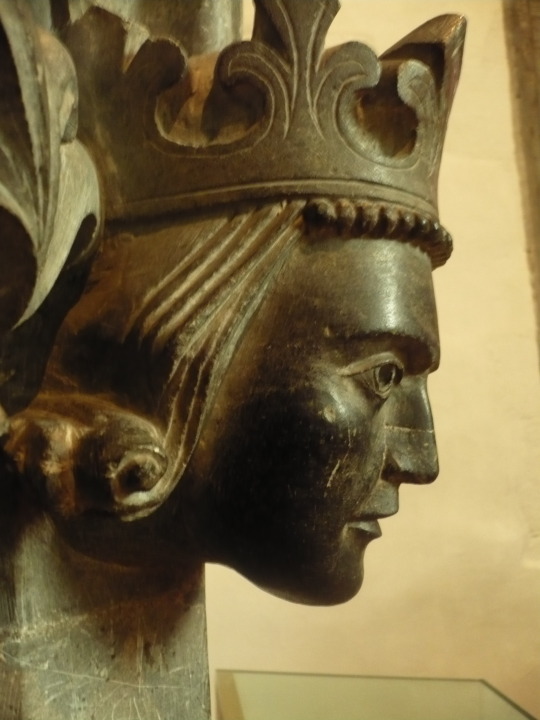
(Eirik Magnusson, king of Norway. In Norwegian history he is known as ‘priest-hater’ and is remembered for his wars with Denmark and for being dominated by his barons. In Scottish history, he is remembered as having two Scottish queens and especially for being the father of the Maid of Norway. Picture from Wikimedia commons.)
After Isobel’s wedding we lack sources again. Little is known about her life as queen consort, excepting the birth of her daughter in 1297. Ingebjørg Eiriksdatter, likely named for her paternal grandmother, was the only one of Eirik II's two known children to survive him; her half-sister, the unfortunate Margaret, had of course died long before Ingebjørg was born. Thus when Eirik himself died in 1299 the crown passed to his younger brother Duke Håkon, and Isobel, consort for only six years, was left a widow with an infant daughter.
Despite the insecurity that could come with widowhood, Isobel was not in any hurry to remarry. She remained on good terms with King Håkon and the new queen, Eufemia of Rügen, and attended important state occasions. Nevertheless, the winds of change were blowing in Norway. Håkon V’s rule was quite different to his late brother's, and he wasted little time disposing of certain former royal councillors, notably imprisoning and executing Audun Hugleiksson by the dishonourable method of hanging. Håkon also favoured Oslo, and during his reign the city began to outstrip Bergen as a centre of royal power. While Norway under Håkon would have more of an eastern outlook, however, Isobel remained in the west for most of her widowhood, playing an important role in the spiritual life of Bergen.
She still had her daughter’s future to think about however, and in 1300 this may have resulted in a plan to marry Ingebjørg to Jon Magnusson, Earl of Orkney and Caithness, though as this betrothal is only recorded in the Icelandic Annals it is difficult to assess its context. Earl Jon was, by each earldom respectively, subject to Norway and Scotland, and his status was defined by this dual allegiance. During the Wars of Independence, he may have inclined towards the Bruce camp, but this is ultimately unclear. But he was still just as much a Norwegian magnate, and perhaps this convenient position between the two kingdoms was what influenced Isobel's choice. Despite the fact that the prospective bride was only three and the earl much older, these plans may also have been put in place to safeguard her daughter’s future given her uncertain inheritance: Barbara E. Crawford believes that the proposed match, “seems to have been a desperate attempt to find a protector for the fatherless child”. The marriage was not to be, however, as Earl Jon died soon after.
This may not have been the end of Isobel’s interests in Orkney however, as a royal official previously strongly associated with her rose to power there soon afterwards. Weyland de Striklaw, who we already met briefly receiving delivery of the goods for Isobel’s trousseau, had once been a canon of Dunkeld and maybe even Alexander III’s chamberlain, but from the 1290s onward he and his brother Henry were more associated with the Bruces. It seems that he may also have had strong personal feelings on the political situation in Scotland, as in 1297 it was recorded that he had been banished by the English regime in Scotland for failing to obey their government. In any case he found employment in the service of the Norwegian Crown, probably as a result of his association with Isobel (then queen consort) whose patronage may partly account for his prominence in Norwegian royal documents during the last years of the reign of Eirik II and the early years of King Haakon’s rule. Fortune favoured him further after the death of Jon, Earl of Orkney, when he somehow managed to become guardian to the earl’s successor, Magnus, and gained control of administration in Orkney and later Caithness. We have little evidence of Isobel and Weyland’s direct cooperation in this affair, but it seems plausible that, given his earlier association with the queen it was partially her influence that helped him secure his position in Orkney, and could be taken as evidence of Isobel’s discreet political activity after her husband’s death.

(A much later depiction- with anachronistic kilts- of Isabella’s sister Mary Bruce imprisoned in a cage outside Roxburgh)
Meanwhile, since Isobel's departure in 1293, Scotland had plunged into the first phase of a bitter and prolonged war, both with England and internally. John Balliol had been deposed by Edward I but rebellions still occurred and others claimed the Scottish throne, most notably Isobel’s brother, Robert. In 1306, he had himself crowned king at Scone, but the first year of his ‘reign’ did not go well and he was forced to flee into the west. It is probable that he took refuge in the Western Isles, and also in the islands of Ireland, though some historians have argued that he could perhaps have gone to Orkney or perhaps even Norway. Certainly the ladies of his court, before being captured and handed over to the English, appear to have been heading to the safety of Orkney, where they would then be able to seek protection in the name of the queen dowager. Instead they remained in English captivity until after 1314. Two of the ladies- Isobel's sister, Mary and Isabella, Countess of Buchan- were quite literally imprisoned in ‘cages’ suspended outside the castles of Roxburgh and Berwick. Another of Isobel’s sisters, Christian, endured a slightly less extreme imprisonment at Sixhills nunnery in Lincolnshire, while her sister-in-law, Robert’s queen Elizabeth de Burgh, was held under house arrest. Young Marjorie Bruce, Isobel’s niece had also originally been intended for a cage but was instead transferred to a convent. Isobel’s brother Niall, who had defended Kildrummy Castle while the women escaped north, was executed by the degrading method of being hanged, drawn, and quartered, while two more of her brothers, Thomas and Alexander, were hanged following a failed invasion of Galloway the following year.
Isobel’s feelings about these family tragedies are unknown, though she might at least have been relieved not to be in Scotland. Even so, she did not forget her kin across the sea and would work to muster troops and funds to send to Scotland in support of her brother's claim. She may also have been a positive influence on the proceedings at Inverness in 1312, where the Scots under her brother Robert I confirmed the Treaty of Perth, which had transferred the Western Isles to Scotland in 1266, with the Norwegians. This event is notable for being the first major diplomatic settlement achieved by Robert the Bruce and it is entirely plausible that his sister played a role as a mediator, though we unfortunately again we lack evidence. She is known to have communicated with Christian (who proved a redoubtable woman in her own right), after her sister's release in 1314, and several decades later the two ladies interceded with their nephew David II on behalf of at least one Norwegian merchant. In the end, of course, their brother Robert did become king of Scots in more than name, enjoying an unparalleled ascendancy in his final years. However Isobel’s only other surviving brother, Edward, was not quite so fortunate in his bid to become High King of Ireland, being killed in battle in 1318 and his corpse quartered. Isobel herself never returned to Scotland; nevertheless, she seems to have kept abreast of affairs there, and was certainly contact with the court of her nephew King David, while she maintained at least some some Scottish servants.
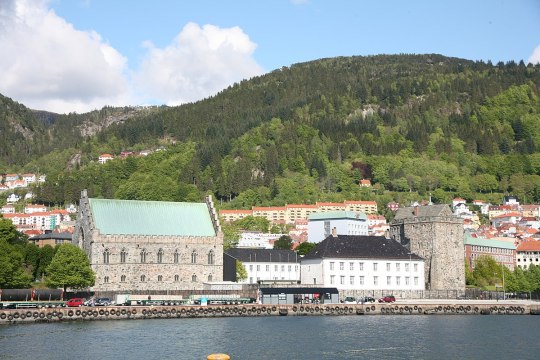
(Bergenhus fortress- this would have been the site of the major royal residence in Bergen during Isobel’s day. The hall on the left was built in the mid-thirteenth century during the reign of her husband’s grandfather Håkon IV- the same king famous in Scotland for his involvement in the Battle of Largs. The tower on the right incorporates the only other surviving mediaeval bit of the fortress, ‘the keep by the sea’, built in the 1270s by Magnus VI, and rebuilt into its present form in the sixteenth century by then governor Erik Rosenkrantz, employing Scottish workmen. Photo from wikimedia commons).
Meanwhile Isobel was busy in Norway. She continued to use her position as queen dowager to influence political affairs and remained on good terms with both Håkon V and, much later, his successor Magnus VII. The latter king was the son of Isobel’s niece, another Ingebjørg, one of the two daughters of King Håkon. In 1312, in a double wedding in Oslo, Isobel’s daughter Ingebjørg and her cousin of the same name married two younger brothers of the king of Sweden. Ingebjørg Håkonsdatter married the elder of the two, Erik the Duke of Södermanland (and other territories), while Ingebjørg Eiriksdatter married Valdemar, Duke of Finland, Uppland, and Öland. Isobel was present at the wedding and probably had a hand in organising the match, but her daughter’s marriage would not last long. The two Swedish princes had long been mistrusted by their elder brother King Birger, and eventually, in 1317, they were arrested at a banquet at Nyköping Castle and held in the dungeons until their suspicious deaths there sometime after January 1318, having possibly been starved to death. Their widows, the Duchesses Ingebjørg, did not simply roll over and accept this, however, and became the leaders of their husbands’ supporters, who in 1318 sent King Birger into exile in Denmark and crowned Magnus, the son of Ingebjørg Håkonsdatter, king of Sweden, while he succeeded his grandfather Håkon V as king of Norway in 1319. The regency was held by Magnus’ mother and grandmother, and Ingebjørg Eiriksdatter also held a seat on the regency council, though it is difficult to ascertain how much influence she actually wielded. We also have no evidence of her relationship with her mother Isobel, which again is very frustrating, but it is likely that Isobel followed the events in Sweden closely, and she would have been even more interested after Magnus VII became king of Norway too, as she remained on friendly terms with the new king.
Most notably, Isobel was heavily involved in the promotion of religious activity in Bergen. In 1305, she attended the consecration of Arne Sigurdsson as bishop of Bergen, an important public occasion at which King Hakon and Queen Eufemia were also present. Whether she was also present in 1301 for the execution of the ‘false Margaret’- a woman who had claimed to be the late Maid of Norway and who inspired a small martyr cult- is unknown, though her strong association with both Bergen and Orkney would have meant that she was well acquainted with the details. In 1324 Bishop Arne’s brother and successor, Audfinn Sigurdsson gifted her several religious houses in Holmen, in return for her donations and patronage of the Church in Bergen. She continued to be associated with the bishops of Bergen in other ways- for example, in 1339, when Isobel and Bishop Haakon Erlingsson successfully interceded with King Magnus on behalf of a prisoner, and the two seem to have worked together politically on other occasions. Religious patronage was often an important part of queenship, but surviving records indicate that Isobel was particularly active in Bergen during her widowhood, and had a strong relationship with the city’s bishops.
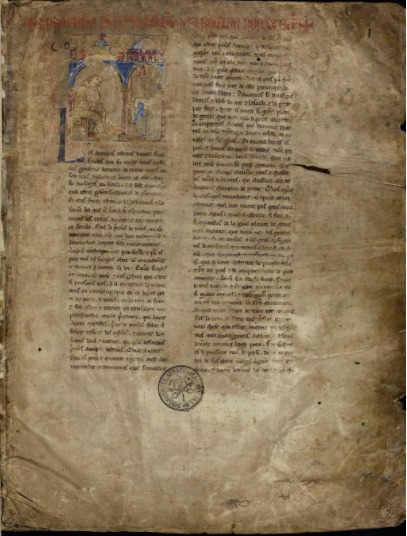
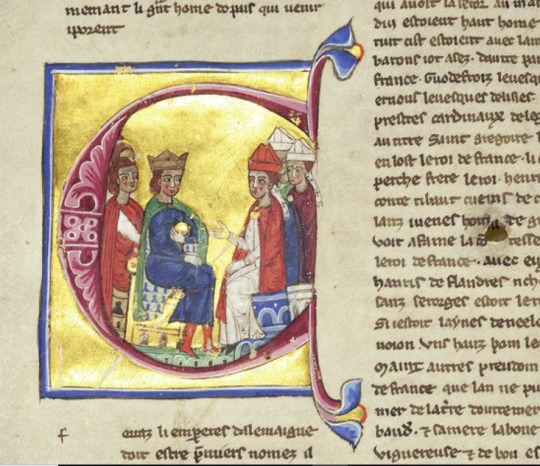
(Above: the first folio from an Old French version of William of Tyre’s “Historia rerum in partibus transmarinis gestarum”, which belonged to Isobel Bruce, and the ex libris announcing her ownership is in red ink across the top of the page. Below: one of the illuminations from the Ms. See here for more of the book.)
Although the church in Bergen where she was buried no longer stands, one particularly fascinating object associated with Isobel has luckily survived the centuries- a manuscript known as Bibliotheca Apostolica Vaticana Pal. Lat. 1963, which contains an Old French translation of William of Tyre’s “Historia rerum in partibus transmarinis gestarum”. This was a crusading chronicle and history of the kingdom of Jerusalem written in the twelfth century, originally in Latin, whose Old French translation became particularly popular in western Europe in the thirteenth century. The version which survives in Pal. Lat. 1963, however, is particularly interesting as it is the only work in French known to have been in Norway in its time period, and furthermore the manuscript itself appears to have been made in the middle east, probably in Antioch, thus raising many questions as to how it ended up in Norway (various Scottish, English, French, Norwegian, and ecclesiastical routes have been theorised, see the article in sources for more). We can be certain that it belonged to Isobel at some point however, as on the first and last folios, the words “Liber Domine Isabelle, Dei gratia Regina Norwegie” are clearly printed in red.
It is unclear what conclusions we can draw about her literary interests from her possession of this book, though Isobel might have had many reasons to be interested in William of Tyre’s chronicle- her father and grandfather are both supposed to have gone on crusade, while it was famously her brother Robert Bruce’s ambition to lead a crusade himself, thus Isobel came from a family with a strong interest in crusade and it is not impossible that this interest was shared by daughters as well as sons. The Norwegians also had their own crusading tradition, most notably during the First Crusade, which is the conflict primarily dealt with in William of Tyre’s history. Even if we cannot be sure that the subject matter reflects Isobel’s personal interests, an indication that at least one of the book’s readers had an interest in Scottish affairs is evident from a piece of thirteenth century marginalia on folio 78vb. Written in French, this is inserted next to a passage which gives a list of various kings (including of England and France) who were on the throne when Jerusalem was captured in the First Crusade in 1099, and adds, ‘et en escoce le bon Roy David le p’mier de ce nom’ (loosely, ‘and in Scotland the good king David the first of this name’). In fact David I did not succeed to the Scottish throne until 1124, but despite this mistake it is interesting that at some point someone reading the manuscript- whether Isobel or perhaps someone associated with her- felt it important to add some Scottish context to the events of this very precious book. (It is also worth noting that the Bruces derived their claim to the throne through their descent from David I’s youngest grandson, while Isobel’s nephew was to become David II). It is unclear if Isobel owned any more books- though given her spirituality and rank it’s entirely possible- and was never famed as a literary patron as her contemporary Queen Eufemia was, but the fact that this book survives offers a fascinating glimpse into the life and interests of an otherwise very shadowy queen.
Isobel lived a long life and she never remarried. Her daughter appears to have predeceased her, and though some sources indicate Ingebjørg may have had children, when she died in Sweden in 1357, Isobel was named as her heir under reversionary law. Around about the same time (1356/7) her similarly long-lived sister Christian died and was interred in Dunfermline, where Robert I was also buried. Isobel herself probably died in 1358, in Bergen. She was possibly in her eighties by then, and had outlived her husband by nearly sixty years. Though we know little about her, and her activity is often shadowy, it seems that she quite ably wielded influence as a queen, particularly as dowager, and her patronage may have been of importance to the careers of men like Weyland de Stiklaw, though often this influence and patronage was exercised discreetly. Her contribution to the histories of Scotland and Norway may have been small, and certainly less adventurous than that of her brother, but nonetheless her career throws up some interesting perspectives on the cultural links of Norway and Scotland, the role of women and queens, and the history of the Bruce dynasty.
*The calendar says the safe-conduct was issued in 1292, but I agree with Barrow that it’s probably misplaced and refers to the following year.
Selected references:
Regesta Norvegica- here, here, here, here, here, here, here, here, here, here, and here (calendared not originals)
Calendar of Documents relating to Scotland, Vol. II
“Islandske Annaler Indtil 1578″, Gustav Storm.
“North Sea Kingdoms, North Sea Bureaucrat: A Royal Official Who Transcended National Boundaries”, Barbara E. Crawford in the Scottish Historical Review, 1990
“A Manuscript of the Old French William of Tyre (Pal. Lat. 1963) in Norway”, by Bjorn Bandlien
“Norwegian Foreign Policy and the Maid of Norway”, Knut Helle in the Scottish Historical Review, 1990
“Robert Bruce: King of Scots”, G.W.S. Barrow
I should also mention that Isabella Bruce has a chapter in “Eufemia: Oslos middelalderdronning” (ed.) Bjorn Bandlien, but the nearest library copy is in London so I was not able to consult it. However if I ever do get the chance I will update any of this as necessary. There were some other books I consulted as well but the above were the major sources.
#Isabel Bruce#Scottish history#British history#Bergen#mediaeval#norwegian history#Robert the Bruce#Eric II of Norway#Norway#people#Scots Abroad#Kings and Queens#women in history#thirteenth century#fourteenth century#Wars of Independence#Hakon V#north sea#House of Bruce#House of Sverre#literary culture#Books and treasures#queenship#illuminated manuscript#Language#clothing
59 notes
·
View notes
Photo

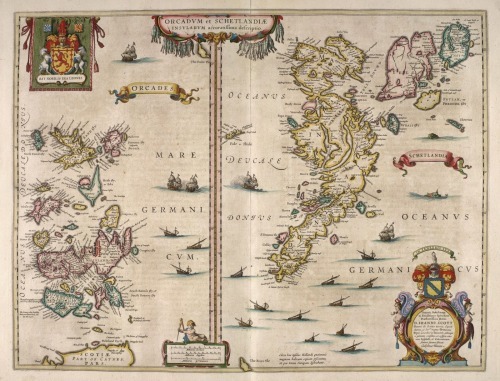
On 20th February 1472 Orkney and Shetland officially became part of Scotland.
Less than four years earlier, in 1468, the Northern Isles were mortgaged to Scotland for 8,000 florins as part of the marriage dowry between the future James III and Princess Margrethe of Denmark.
But you have to go back a wee bit further for some of the history, following the Battle of Largs, in 1263, and the loss of the Western Isles as a result of the Treaty of Perth, in 1266, Orkney and Shetland were the only part of what is now Scotland to remain in Norwegian hands.
Although the islands were still officially under Norse rule, the control Scottish Earls had over Orkney was on the increase.
This culminated in the appointment of Henry Sinclair, Earl of Roslin to the Earldom in 1379, and heralded changes in the ownership of land and the gradual break-up of the Norse systems of tenure.
The Earldom of Orkney was held for the Norwegian (and later Danish) Crown until 1468, at which time the impoverished Christian I, King of Denmark, Norway and Sweden, “motygaged” Orkney to the Scottish Crown as part of a marriage agreement with King James III.
The Scottish king was to marry Christian’s daughter, Margaret, and by this agreement Orkney was held as a pledge, redeemable by the payment of 50,000 Rhenish Florins.
At the end of the first year the payment had not been forthcoming so Shetland was pledged for a further 8,000 Florins.
Two years later, Christian had still not made the payment so the Earldom of Orkney and Lordship of Shetland were annexed to the Scottish Crown.
As the years passed, the Scottish influence over the islands grew and gradually the Norse way of life and language slipped away. By the late 17th century the variant of the Norse language of Orkney - Norn - was spoken only by the inhabitants of one or two remote parishes.
In 1564, Mary Queen of Scots gifted the Royal Estates in Orkney and Shetland to one Robert Stewart - her half-brother and natural son of James V. Thus began the tyranny of the Stewart line - traditionally hailed as Orkney’s darkest years.
Robert Stewart’s acquisition, and subsequent “handling” of the islands, was documented as followed:
“This miscreant, having secured in addition the whole temporal estates of the bishopric by an excambion effected in 1568, and having become Earl of Orkney in 1581, spent the rest of his life - with the exception of a short period during which he was imprisoned, partly as a penalty for improper negotiations with Denmark - in oppressing the islanders for his own personal advantage.”
43 notes
·
View notes
Text
The Daily Thistle
The Daily Thistle – Historical and Archeological News From Scotland
Friday 7th September 2018
"Madainn Mhath” …Fellow Scot, I hope the day brings joy to you…. The first thing I will ask you to do, is SHARE this edition of The Daily Thistle as Facebook has restricted me once again from sharing to groups I do not control or am an Admin of… so please SHARE the hell out of this post… on a more Happier note they have been digging up the Queens garden and finding all sorts of stuff and as I get more information I shall let you know.. so read on and enjoy.. I’m going to have another cup of coffee..
QUEEN'S EDINBURGH RESIDENCE YIELDS 800-YEAR-OLD ARTIFACTS…. EDINBURGH, SCOTLAND—According to a BBC report, archaeologists have uncovered artifacts going back 800 years at the Palace of Holyrood House, Queen Elizabeth II's official residence in Scotland. Discoveries include a twelfth-century jug fragment, a horse skeleton, and a medieval shoe, as well as a cache of oyster shells and wine bottles. The latter may provide insight into the diets of courtiers and ambassadors during the reigns of Mary, Queen of Scots, and James VI of Scotland, who became James I after being crowned king of England in 1603. Researchers also unearthed wine and spirit vessels, food remains, and fragments of children's games, which belonged to families living in nearby tenements during the eighteenth and nineteenth centuries. "The survey has provided a unique opportunity to understand more about the fascinating development of the Abbey Strand and its surroundings," says archaeologist Gordon Ewart, referring to the stretch of Edinburgh's Royal Mile that culminates at the palace, "and to explore how the site has been the historic and symbolic bridge between the palace and the city of Edinburgh for centuries."
ON THIS DAY IN HISTORY…. This day in 1836 saw the birth of Henry Campbell Bannerman, the British Prime Minister. Born in Glasgow and educated at Glasgow and Cambridge, Bannerman became the Liberal MP for Stirling in 1868, a position he held until his death. He climbed the parliamentary ranks, serving as Secretary for Ireland during Gladstone's administration in 1884 and entering the cabinet as Secretary for War in 1886, before becoming leader of the Liberal Party in 1899. Bannerman became Prime Minister in 1905 following Balfour's resignation, and led his party to a landslide victory in the 1906 general election. His brilliant cabinet included Asquith, Lloyd George, and Winston Churchill. Ill health forced Bannerman to hand over the leadership to Asquith, and he died two weeks later in 1908.
GAVIN MAXWELL PASSED AWAY ON THIS DAY…. He lived from 15 July 1914 to 7 September 1969. He was a naturalist and author, best known for his work with otters. His most popular book was Ring of Bright Water, published in 1960. This described how he brought an otter back from Iraq and raised it in Scotland. The otter, Mijbil, was eventually identified as a previously unknown sub-species of the Smooth-coated Otter, since named after Maxwell: Lutrogale perspicillata maxwelli. The book went on to sell over a million copies and was made into a film. The sub-species Lutrogale perspicillata maxwelli may have fared less well: following extensive drainage of its natural environment in Iraq it is feared to be extinct… I must at this point tell you he had nothing to do with a Silver Hammer..
IN THIS WEEK…. The Shetland Isles were mortgaged to Scotland for 8,000 florins as part of the marriage agreement between the future James III and Princess Margrethe of Denmark. For the most northerly railway in Britain, go to Thurso. For the "most northerly" of just about anything else, you need to come to Shetland. The name, sometimes in the past referred to as Zetland (hence the "ZE" beginning to postcodes), comes from the Norse name for the islands, Hjaltland. For accommodation in Shetland see the links in the "See and Stay" menu above. See the map below for an outline of Shetland and links to connecting areas. Because most maps of Scotland include Shetland in a box near the top right hand corner, not many people have a strong sense of where this archipelago of 100 islands and islets lies. It comes as a surprise to many to discover it is nearer Bergen than Aberdeen; that it is further north than Moscow or southern Greenland; and that Lerwick is as far as Milan from London. The population of Shetland is around 23,000. Shetland was Norse until 8 September 1468, when the islands were mortgaged to Scotland for 8,000 florins as part of the marriage agreement between the future James III and Princess Margrethe of Denmark. In 1472 the Scots annexed both Shetland and Orkney.
HUGH MACDIARMID PASSED AWAY THIS WEEK IN 1951….Hugh MacDiarmid, was the pen name of Christopher Murray Grieve, who lived from 11 August 1892 to 9 September 1978. He is widely regarded as the most important Scottish poet of the 20th Century.
He moved with his wife to Biggar in 1951 and that was where died on 9th September 1978. In all Grieve/MacDiarmid published around 30 books and many shorter works and articles. The poetry he produced in his later life is often viewed as difficult and inaccessible, but brilliant. The two volume Complete Poems, published after Grieve's death, ran to 1500 pages.
On that note I will say that I hope you have enjoyed the news from Scotland today,
Our look at Scotland today is of a peculiar nature or is that, nature at it's most peculiar...?
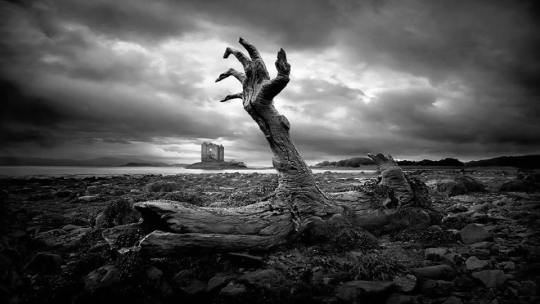
A Sincere Thank You for your company and Thank You for your likes and comments I love them and always try to reply, so please keep them coming, it's always good fun, As is my custom, I will go and get myself another mug of "Colombian" Coffee and wish you a safe Friday 7th September 2018 from my home on the southern coast of Spain, where the blue waters of the Alboran Sea washes the coast of Africa and Europe and the smell of the night blooming Jasmine and Honeysuckle fills the air…and a crazy old guy and his dog Bella go out for a walk at 4:00 am…on the streets of Estepona…
All good stuff....But remember it’s a dangerous world we live in
Be safe out there…
Robert McAngus
#Scotland
#News
#Spain
1 note
·
View note
Text
D.U.D.E Bios: Ivor Rhydderch
The Ogre Prince of C.R.C Ivor Rhydderch (2020)

Kirby's cousin, Hywel's nephew, and Rhodri's son, Ivor. An Irish-Catholic living in Wales and a gentle and honest father. He tries his hardest to ignore his brothers pranks.
"Go be gross somewhere else."
Name
Full Legal Name: Ivor Lonán Dylan Brian Rhydderch
First Name: Ivor
Meaning: From the Old Norse name 'Ívarr', which was probably derived from the elements 'Ýr' 'Yew tree, Bow' and 'Herr' 'Army, Warrior'
Pronunciation: IE-var
Origin: Irish, Scottish, Welsh, English
Middle Name(s): Lonán, Dylan, Brian
Meaning(s): Lonán: Means 'Little Blackbird', derived from Old Irish 'Lon' 'Blackbird' combined with a diminutive suffix.
Dylan: From the Welsh prefi 'Dy' meaning 'To, Toward' and 'Llanw' meaning 'Tide, Flow'
Brian: Meaning Uncertain, possibly related to the Old Celtic root 'Brixs' 'Hill, High' (Old Irish 'Brii') or the related 'Brigā' 'Might, Power' (Old Irish 'Briig')
Pronunciation(s): LUW-nan. DUL-an. BRIE-an
Origin(s): Irish, Old Irish. Welsh, English, Welsh Mythology. English, Irish, Old Irish
Surname: Rhydderch
Meaning: From the given name 'Rhydderch', from the Old Welsh name 'Riderch', derived from 'Ri' 'King' and 'Derch' 'Exalted'
Pronunciation: HRUDH-ehrkh
Origin: Welsh
Alias: Ogre Prince, Ivor Rhydderch
Reason: This is Ivor's ring name
Nicknames: Ivo, Bri
Titles: Mr
Characteristics
Age: 35
Gender: Male. He/Him Pronouns
Race: Human
Nationality: Welsh. Irish-Welsh Mix. Dual Citizenship ROI-UK
Ethnicity: White
Birth Date: November 25th 1985
Symbols: Ogres, Ogresses, Crowns
Sexuality: Heterosexual
Religion: Irish-Catholic
Native Language: Welsh
Spoken Languages: Welsh, Irish, Scottish (Scots Gaelic), English
Relationship Status: Married
Astrological Sign: Sagittarius
Theme Song: 'Jesse James' - The Pogues (2003-)
Voice Actor: Aidan Turner
Geographical Characteristics
Birthplace: Tullahought, Kilkenny, Ireland
Current Location: Llanfaethlu, Anglesey, Wales
Hometown: Llanfaethlu, Anglesey, Wales
Appearance
Height: 6'2" / 187 cm
Weight: 300 lbs / 136 kg
Eye Colour: Blue
Hair Colour: Ginger
Hair Dye: None
Body Hair: Hairy
Facial Hair: Clean Shaven
Tattoos: (As of Jan 2020) 20
Piercings: Ear Lobes (Both)
Scars: No Noticeable Scars
Health and Fitness
Allergies: None
Alcoholic, Smoker, Drug User: Smoker, Social Drinker
Illnesses/Disorders: None Diagnosed
Medications: None
Any Specific Diet: None
Relationships
Allies: (As of Jan 2020) The Rhydderch Clan
Enemies: (As of Jan 2020) None
Friends: Jarlath Rhydderch, Patrick Rhydderch, Lochlainn Rhydderch, Uilliam Rhydderch, Sean Rhydderch, Wyn Rhydderch, Vaughan Rhydderch, Neifion Rhydderch, Roderick Rhydderch, Flann Rhydderch, Heath Ott, Urbano Marino, Zacarías Huerta, Donato Santos
Colleagues: The C.R.C Locker Rooms / Too Many To List
Rivals: None
Closest Confidant: Oneida Rhydderch
Mentor: Rhodri Rhydderch
Significant Other: Oneida Rhydderch (36, Wife, Née Richelieu)
Previous Partners: None of Note
Parents: Rhodri Rhydderch (77, Father), Grania Rhydderch (78, Mother, Née Mac Ghabhann)
Parents-In-Law: Carbrey Richelieu (56, Father-In-Law), Aran Richelieu (57, Mother-In-Law, Née Cullen)
Siblings: Fionn Rhydderch (47, Brother), Aisling O'Hannigan (44, Sister, Née Rhydderch), Caoimhe O'Hannegan (41, Sister, Née Rhydderch), Uilliam Rhydderch (38, Brother), Eithne O'Hannagan (32, Sister, Née Rhydderch)
Siblings-In-Law: Unity Rhydderch (48, Fionn's Wife, Née Sauvageon), Keaton O'Hannigan (45, Aisling's Husband), Cadell O'Hannegan (42, Caoimhe's Husband), Whitney Rhydderch (39, Uilliam's Wife, Née Sauvageau), Januarius O'Hannagan (33, Eithne's Husband)
Nieces & Nephews: Rachel MacGregor (27, Niece, Née Rhydderch), Bruce MacGregor (28, Rachel's Husband), Queen MacEntire (24, Niece, Née Rhydderch), Coinneach MacGregor (25, Queen's Husband), Pace Rhydderch (21, Nephew), Urve Rhydderch (22, Pace's Wife, Née MacEalair), Odin Rhydderch (18, Nephew), Naomh Rhydderch (15, Niece), Macy Rhydderch (12, Niece), Comhghall Rhydderch (9, Nephew), Kaiser Rhydderch (6, Nephew), Jacinth Rhydderch (3, Niece), Ida Scott (24, Niece, Née O'Hannigan), Cillian Scott (25, Ida's Husband), Hale O'Hannigan (21, Nephew), Briallen O'Hannigan (22, Hale's Wife, Née Sangster), Faith O'Hannigan (15, Niece), Eartha O'Hannigan (12, Niece), Dagda O'Hannigan (9, Nephew), Cade O'Hannigan (6, Nephew), Bambi O'Hannigan (3, Niece), Aaliyah Wallace (21, Niece, Née O'Hannigan), Matháin Wallace (22, Aaliyah's Husband), Zayden O'Hannegan (18, Nephew), Yorick O'Hannegan (15, Nephew), Xavia O'Hannegan (12, Niece), Wednesday O'Hannegan (9, Niece), Vance O'Hannegan (6, Nephew), Uhtric O'Hannegan (3, Nephew), Tacey Rhydderch (18, Niece), Sadb Rhydderch (15, Niece), Raeburn Rhydderch (12, Nephew), Quirinus Rhydderch (9, Nephew), Paisley Rhydderch (6, Niece), Olive Rhydderch (3, Niece), Iain O'Hannagan (12, Nephew), Haidee O'Hannagan (9, Niece), Garnet O'Hannagan (6, Niece), Fabius O'Hannagan (3, Nephew)
Children: Napoleon Rhydderch (15, Son), Macdara Rhydderch (12, Son), Lalla Rhydderch (9, Daughter), Kayleen Rhydderch (6, Daughter), James Rhydderch (3, Son)
Children-In-Law: None
Grandkids: None
Great Grandkids: None
Wrestling
Billed From: Kilkenny, Ireland
Trainer: The C.R.C Wrestling School, Rhodri Rhydderch
Managers: Oneida Rhydderch
Wrestlers Managed: Oneida Rhydderch
Debut: 2003
Debut Match: Ivor Rhydderch VS Rhodri Rhydderch. Double Count Out
Retired: N/A
Retirement Match: N/A
Wrestling Style: Grappler
Stables: The Rhydderch Clan (2003-)
Teams: No Team Names
Regular Moves: Rotating Punch To The Stomach, Backbreaker, Running Knee Lift, Belly To Belly Suplex, Diving Shoulder Block, Dropkick, Gorilla Press, Lariat, Scoop Powerslam, Spinning Spinebuster, Three Point Stance Tackle, Tiger Suplex
Finishers: Boston Crab, Senton, Sitout Gutwrench Powerbomb, High Angle Belly To Back Suplex
Refers To Fans As: The Fans, The Family
Extras
Backstory: Ivor Rhydderch of the C.R.C (Welsh Wrestling League / Cynghrair Reslo Cymru) owning Rhydderch Family. When Rhodri dies Ivor will have a 1/48th ownership of the promotion. Ivor is an 'Ogre Style' (Grappler) trainer. He's a quarter-Welsh and three quarters-Irish
Trivia: Nothing of Note
#D.U.D.E#original character#Rhydderch#C.R.C Wrestling Family#C.R.C Wrestling Promotion#C.R.C Wrestling School
5 notes
·
View notes